#surely the European Union is interested in peace in the region
Note
you are a disgusting piece of shit like kill yourself or die along with those terrorists
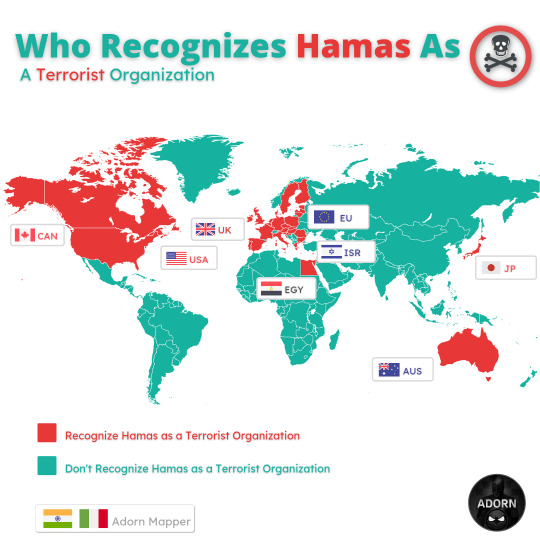
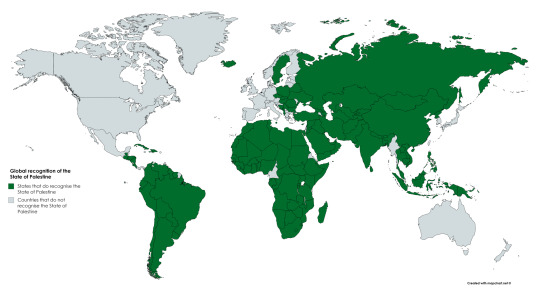
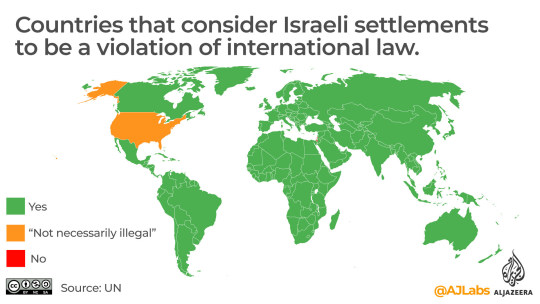
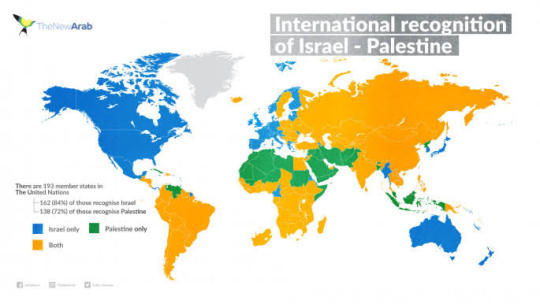
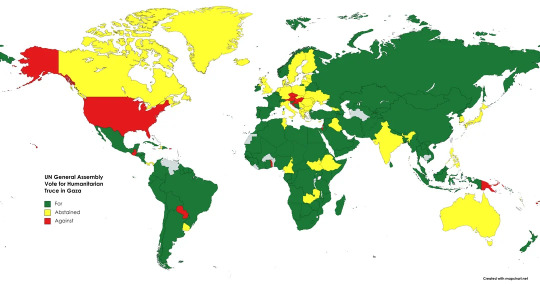

Hope this helps 👍
#like do u really see nothing sus here#most of the world considers notable Palestinian groups to be resistance fighters#‘Israel’ was established by what like British mandate wow good thing they’ve never done any wrongs#and wow America supports them whew glad that makes it clear they’re on the ‘right’ side as the West always is#surely the European Union is interested in peace in the region#there is no way they would benefit by the region remaining in conflict due to literally the entire region wanting that state dissolved#literally no one anywhere else is surprised its America and allies(TM) making ridiculous claims in the media and in international meetings#wanting settlers off occupied land is good and Palestinians deserve their homes back actually#the ability to research information yourself is clearly available if you are sending random anons#your ignorance is willful#and your hate-mail is subpar#i couldn't even tell who you were referring to as 'terrorists'#''like die''#i read your message in a shaggy voice#Language!#L!
42 notes
·
View notes
Text


Very interesting look-back on the geopolitical maneuvering that took place in the few years following the collapse of the Soviet Union.
If you weren’t around or don’t recall those halcyon days the establishment was fairly open about what it was doing even if it was dishonest about the ramifications and what it meant for the American people or the peoples of Europe.
It’s like telling the plebs that the American economy would transition to “Service Based”. It doesn’t sound bad and surely our elected representatives and establishment institutions have the people’s interests at heart. Right? The reality is that it means your nation becomes a net consumer, capital outflows, fiat currency on steroids, steady to spiking inflation, a lower standard of living and depressed real wages.
This same bait and switch was happening with the EU, Euro, and the eurozone. What started sold as a common currency and free trade region amongst finally peaceful and modern but distinct nations eventually betrayed itself as a globalist plan to destroy the sovereignty of the European states and subject their various people to a centralized technocratic power structure.
This handling of the former Soviet republics, attempting to keep integrated with a larger centralized power was the same game. The assumption was Russia had been brought to heel and could be used by the same interests in to create an eastern EU analogue.
Rest in the link.

46 notes
·
View notes
Text
Adriatic Tour - September 2019
My fourth Rick Steves tour, and the second in 2019, was his Best of the Adriatic. A two-week tour taking in Slovenia and Croatia, with an overnight stop in Bosnia. Seeing three of the now seven nations created when Yugoslavia broke apart in the 1990s.
A Bit of History
Yugoslavia was created after World War I with the defeat of both the Austria-Hungarian Empire and the Ottoman Empire. That changed in the 1990s when the regions started to breakaway to create independent nations.
Slovenia in the north is a member of the European Union and in the Schengen Zone. Thus my arrival in Europe in Munich was sufficient for my passport to be stamped. Slovenia also is on the Euro, so money I had leftover from my previous trip was used for the first several days. And, because of the borders, and the Schengen states, we seamlessly drove within Slovenia with a 30-minute drive into Italy on the outskirts of the city of Trieste.
Croatia and Bosnia on the other hand have their own currencies and tighter border controls. We went through customs and passport control as we passed through those borders. The Croatian Kuna is the Croatian currency with little acceptance of Euros. The tour made sure we did not need to have any of the Bosnian currency by having group lunch and dinner during our stop in Bosnia. Breakfast of course was included with the hotel. Luckily the gelato vendors in Mostar near the famous bridge took Euros or Kunas.
Slovenia
The main highlights of Slovenia was Ljubljana, the capital and Lake Bled.
Ljubljana is an old-world city with cafes and wide streets for easy walking. Clearly the Austria-Hungarian influenced the growth and culture of the city. I spent hours walking along pedestrian streets and into squares simply enjoying the ambiance of the city. One highlight was to see several buildings designed by a famous local architect, Joze Plecnik. One currently is a high school that was a block from the hotel we stayed, and the other is a university library. The playfulness of the library is that windows are shaped as if they were open books.
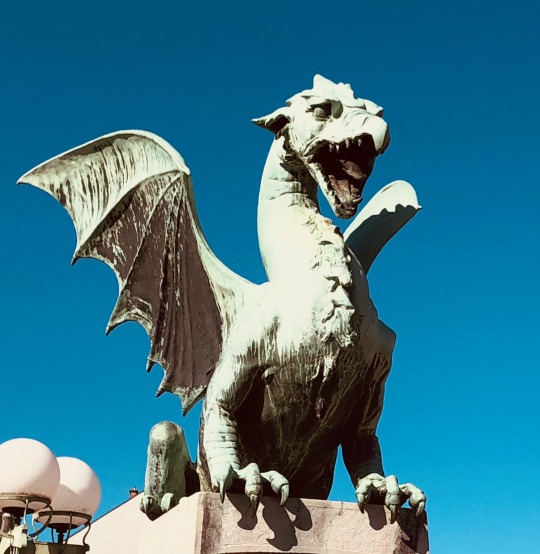




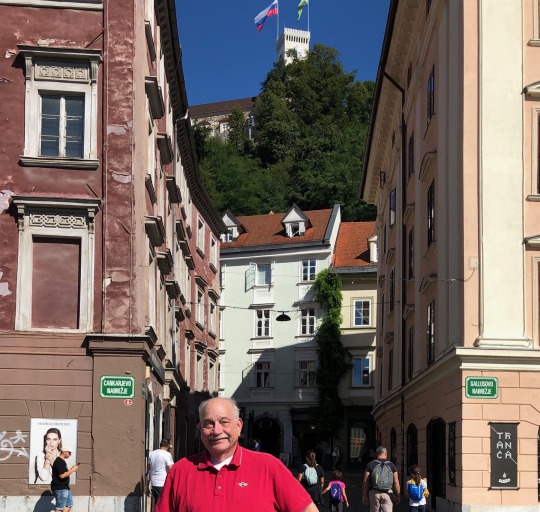


Lake Bled is within the Julian Alps and close to the Austrian and Italian borders. I’ve been told the only island in Slovenia is the small one in the lake with a church on it. A castle commands a high view from one side of the lake. After touring the castle, we were given time to stroll, hike, walk around the lake. That was a serene and beautiful way to see this marvelous place. Actually I did not walk totally around the lake but went about half way to 2/3 in one direction and returned the same way. So, yes, may not have walked all the way around, but covered the same distance. Preferred to stay in woodsy forest setting than ending up in the developed town by the lake. One note, a villa used by Yugoslavian strongman Marshal Tito now is a small hotel.



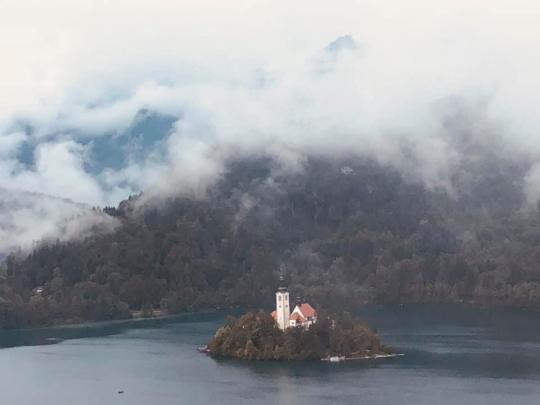
Other highlights of Slovenia is the beautiful vistas driving through the Julian Alps and a stop in the town of Kobarid to see a World War I museum. Several major battles were fought in the area and a young Ernest Hemingway served as an ambulance driver which he later turned into his novel A Farewell to Arms.
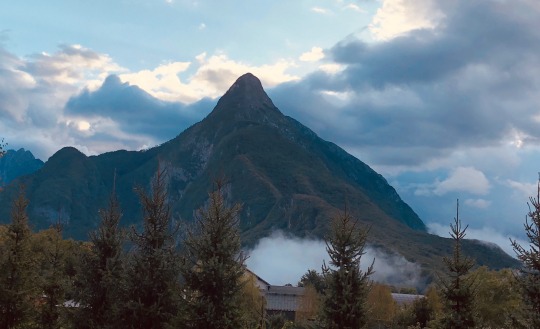
It was during this final stretch in Slovenia that we crossed into and out of Italy in about 30-minutes.
Croatia
The bulk of the two-week tour was in Croatia mainly spending the time along the Adriatic coast from the Istrian Peninsula down to Dubrovnik.
Istrian Peninsula juts out into the Adriatic and is close to Venice and the Italian coast. Supposedly from the town of Rovinj you could see Venice on a clear day. Well they say that but I didn’t. There is a heavy Roman and Venetian influence in the towns we saw including Roman amphitheater in Pula.

Rovinj
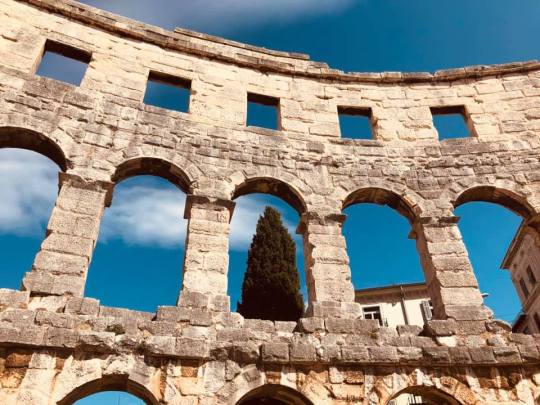
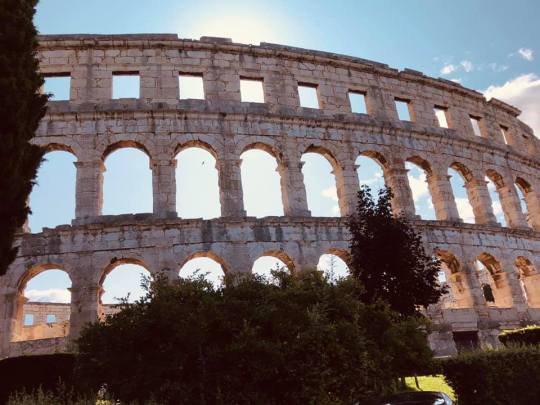

Three from Pula
Venetian influence is seen in Rovinj and Opatiija. As I walked into the warrens of the streets of Rovinj, I felt as if I was walking in Venice or a Tuscan or Umbrian hill town. It was as close to feeling in Italy without being there.


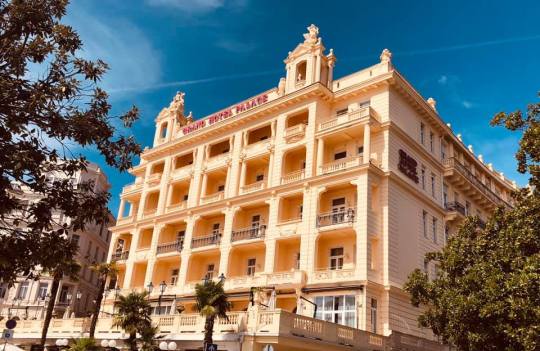
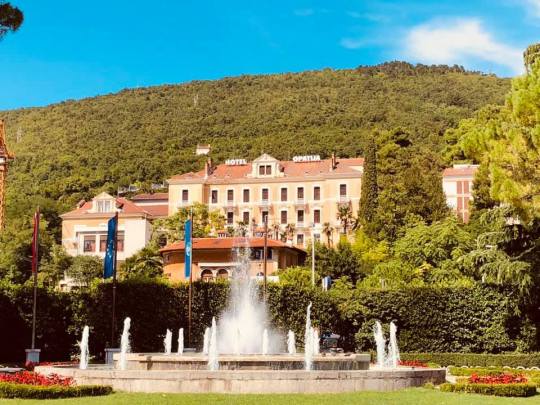

5 photos of Opatija
The interesting note about the Istrian Peninsula is that the towns all have two names, the Croatian name and an Italian name even though it has been centuries since the area was under Roman or Venetian control.
Plitvice Lakes National Park is an absolute jewel. The tour made sure we entered the park early in the morning at one end that is not the usual entrance for tourists. The goal was to walk through the park which is full of lakes and waterfalls until we arrived at the main entrance. It was a six mile, 16,000 steps walk seeing amazing vistas and waterfalls all by noon! I don’t think my photos do it justice. At one point I mentioned to someone I was walking with that it reminded me a bit like Milford Sound in New Zealand. Within minutes heard someone going in the other direction say the same thing.

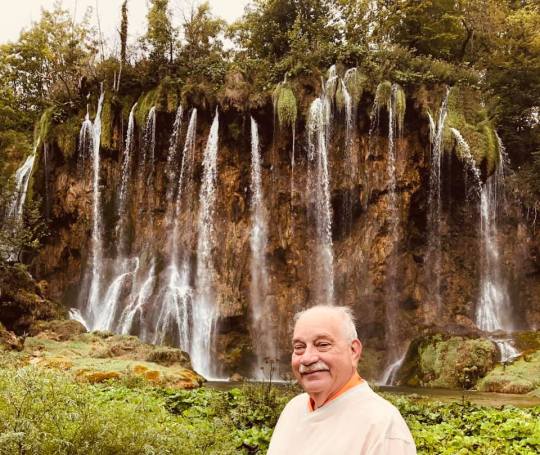




Even though the tour guide was specific about where we should meet near the end of the trail, we lost four women. I later said they saw the walk through the park as a race and not a walk. They were in front of all of us and took the wrong turn near the trail end. While we waited where we were suppose to be, they ended up walking back to where we entered the park! Of course we found them but had to change where we would have lunch since their misadventure forced a change of plans.
Split
One of the jewels of Croatia is Split. An amazing beautiful city nestled on the Adriatic. We spent two nights there (thank goodness, was able to get laundry done) and was absolutely beautiful. Was supposed to meet up with my ex-boss who was going to be there at the same time, but he cancelled on me. So I spent free time walking along the seaside walkway.
The main tourist attraction is the remains of the Roman emperor Diocletian’s palace. The modern city used the remnants as a base to build along the waterfront. One part of the basement of the palace that is intact supposedly was used in the filming of the HBO show “Game of Thrones.”




I was able to find the synagogue in Split which is barely used for services on Saturdays or for holidays.



Split is definitely a place I would return to if the opportunity came again.
Korcula
A two-week tour is somewhat exhausting so the last weekend we were given a free day on the island of Korcula. It is off the coast of Croatia between Split and Dubrovnik. To get there we had to take a ferry from the mainland. And we needed the break. Absolutely gorgeous with amazing views of the Adriatic. I had not planned on bringing a bathing suit to go into the sea but if I had to do it over, would have just to get into the Adriatic. As is, I was only able to dip my toes and hands.




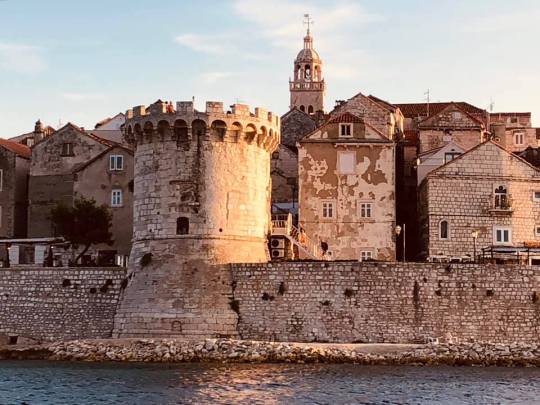

Dubrovnik
The old city is an amazingly beautiful walled city. We were given a walking tour by a local who lives inside the walled city. Luckily we did the tour in the morning beating the crowds from a cruise ship that disgorged hundreds of tourists into the small area of the walled city. Clearly a case of over-tourism. There were more tourists than necessary for us to fully enjoy the scenery.
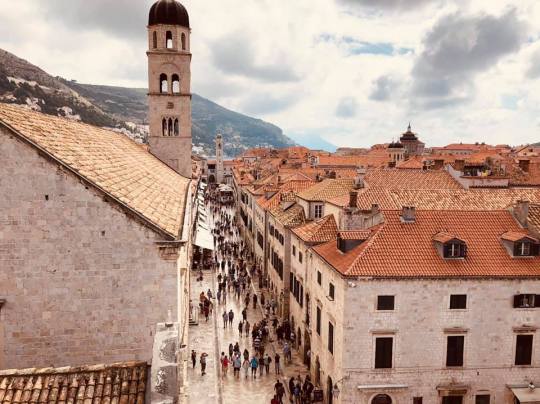

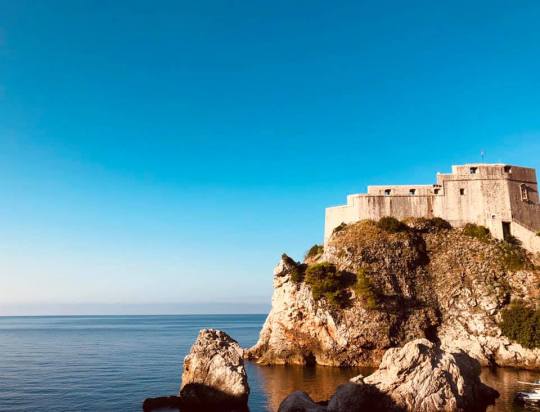
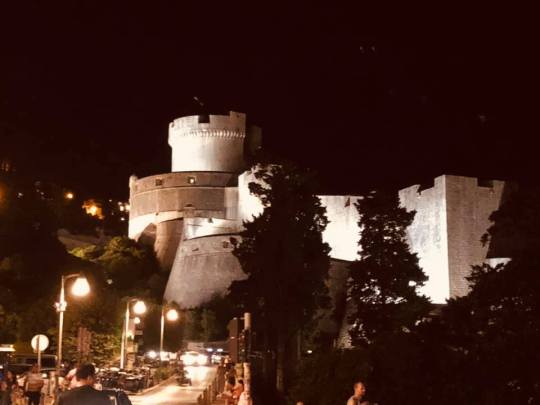


The highlight of the day was walking around the city wall and seeing the city below in its full beauty. And, similar to Split, I was able to go to the synagogue which is now a non-working synagogue.



Bosnia
One of the “Wow moments” of the tour was our overnight trip to Mostar in Bosnia. Mostar sits in a river valley with high hills surrounding the city. It was from those heights that the town was shelled during the siege that devastated it during the wars in the 1990s.
The famous arched old bridge was destroyed - a bridge that was originally built by the Ottomans in the 16th Century. As the area calmed down and peace was relatively restored the bridge was rebuilt and is the main tourist attraction in the old town area. Locals will solicit money before diving off the bridge into the river. The crowds swell to see this sight. And, according to the tour books, so do the pickpockets. Luckily didn’t bother me.




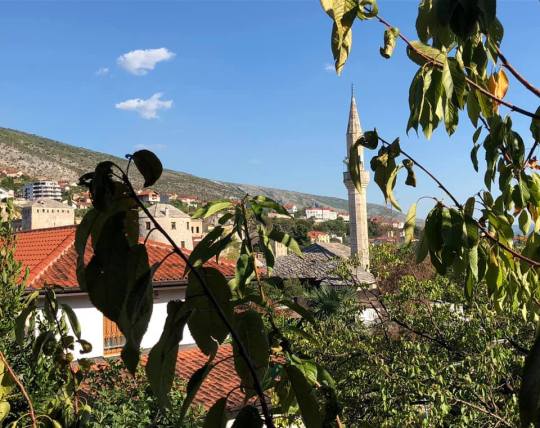
We had a local guide, a Bosnian Muslim who described how she and her family survived the shelling and the siege. At one point when the bridge was destroyed, her family was divided by the river without contact from the other side for weeks. She recalled her brother still has shrapnel from a shelling that also killed her uncle. We saw numerous buildings still with signs of being damaged from the war.
She was not enthusiastic about the peace accord that ended the war. The agreement was brokered by the Clinton Administration and established a couple of autonomous ethnic zones, especially one for Serbians. She felt that has led to a country with multiple presidents and a lack of cohesion as a nation. However so far that agreement has held.
Observations
This was a region of Europe on my “must see” list for some time. Now I can go to other parts of Europe without wondering will I get to the Adriatic area. A member of the tour said to me that it is a tribute to Leila that I continue to travel, something we loved to do together.
Loire Valley and South France in spring 2020 and South Italy in October 2020 coming up.
1 note
·
View note
Text
The EU Is At War With Israel

It's official. For all intents and purposes, the EU is at war with Israel.Some of the members, particularly in Eastern and central Europe aren't participating, but most of the EU is.
It isn't a shooting war, but an increasing effort to marginalize the Jewish State so it can be destroyed..
The EU supports anti-Israel NGOs financially,and continues to fund the PLO even though it uses much of those funds to pay terrorists for murdering Israeli civilians, even though that financial support frees up funds to be used in what the PLO refers to as 'operations.'
Only Israel has fruits, vegetables and fresh flowers specially labeled as being from 'the Occupied West Bank.'
Led by Angela Merkel and Frances Emanuel Macron, the EU has consistently evaded U.S. sanctions against Iran and continued to observe the farcical Iran 'deal' of Barack Hussein Obama. The EU has done this even though Iran has been quite clear of its genocidal intentions towards Israel.
And it was none other than Germany's Angela Merkel who pressured Eastern and Central European countries with good relationships with Israel not to relocate their embassies in Jerusalem or face her wrath.
The founding director of the European Coalition for Israel in Brussels, Tomas Sandell, reported that that the German Chancellor waged a strenuous campaign to stop central and eastern European countries from moving their capitals to Jerusalem..
“I have spoken to many Germans these last few days in Brussels,” he said. “They are not aware of this, and all of them would be shocked that all of the countries in the European Union today would want to block an embassy move to Jerusalem, not only for your own country, but for other countries that have the conviction [that] this is the right thing to do, the only country to do would be Germany. This is a big shock.”
According to Sandell, most of Merkel’s calls to put the squeeze on European leaders happened when “many of the nations were seriously considering moving their embassies.”
This isn't a shock to me at all,but let's continue.
Germany also implemented the marking of Israeli goods from 'disputed territories' in 2015. Not only did Germany start the labeling, but Merkel used her influence to get other Eu nations to do the same.The idea, of course is to further isolate Israel as an 'occupying power.'
As recently as a few days ago, the EU showed that it had chosen sides against Israel. When American U.S. Ambassador Nikki Haley tried to discuss aspects of President Trump's proposed peace plan, they essentially brushed it off. Let's look at their official statement and then dissect what it really means.
After the usual horse manure about a 'just peace 'based on international law, relevant UN resolutions and previous agreements', here's what they said:
"The EU is truly convinced that the achievement of a two-state solution based on the 1967 borders with Jerusalem as the capital of both States, that meets Israeli and Palestinian security needs and Palestinian aspirations for statehood and sovereignty, ends the occupation and resolves all final status issues, in accordance with Security Council Resolution 2334 and previous agreements, is the only viable and realistic way to end the conflict and to achieve just and lasting peace."
Let's translate this, shall we?

Resolution 2334 is the one former President Barack Hussein Obama engineered when the Security Council had a majority of anti-Israel countries on it and then made sure the US abstained so it would pass, his final hateful attack on Israel. Here's what it stipulated, and it's an 'anti-zionist' wet dream.
First of all, it negates every Israeli community as illegal outside the pre-1967 lines and gives East Jerusalem to the PLO. This creates 580,000 homeless Israeli refugees, bars them forever from all their holy sites, and puts all of Israel's central plain and its airports in easy missile and mortar by giving Israel's sworn enemies the high ground.

Not only that, it also takes away any notion of security from what's left of Jerusalem that the resolution is willing to leave to Israel. The Israelis themselves had previous experience with this in 1967, when Jordan's King Hussein announced his entry into the war by shelling civilians and having snipers fire on West Jerusalem
Even worse, there would be nothing to stop Iran from supplying deadlier and deadlier missiles and arms to both the PLO and Hamas. With the Jordan Valley out of Israeli control, there would be nothing to stop Iran from moving troops, missile launchers and armor to Israel's new borders.
Essentially, what the EU was saying to Ambassador Haley is that they weren't going to support President Trump's plan whatever it was, that Israel should be moved to indefensible borders, and that its enemies should have every strategic advantage so they can finally destroy it.
2334 also violates the Oslo Accords and the Road Map, agreements the U.S. was a signatory to that stated unequivocally that any settlement between Israel and the Palestinian Authority could only be achieved through direct negations between the two parties.
And then of course, there's that notion of 'occupation.' That term has always been used to describe one country forcibly invading and taking control of another country's sovereign territory. And sovereign territory means land inside another established country's recognized borders, like Saddam Hussein occupying Kuwait or the US occupying Germany or Japan.
So we have to ask the question...which country's sovereign territory is Israel 'occupying?'
It can't be Jordan. Yes, Jordan illegally occupied Judea, Samaria (AKA The West Bank) and East Jerusalem in the 1948 war for 19 years after ethnically cleansing the Jewish population in this area, but the UN never recognized these areas as Jordanian territory, Israel took it back in the Six Day war after Jordan attacked them and Jordan later gave up all claims to this area as part of their peace treaty with Israel. So it isn't Jordan Israel's occupying.
And it can't be 'Palestine' either. It never existed as a sovereign nation with established borders at all. Owning a house in say, Pennsylvania does not make it and maybe your yard a sovereign country, now does it?
So there really is no 'occupation.' According to the San Remo Accords between the League of Nations (the UN of its day) and Britain in 1922, the 22% of the Palestine Mandate that includes Judea and Samaria and what is now Israel was supposed to be the Jewish State, while the 78% of it that's now Jordan was supposed to be the Arab State. It's the only partition of the area both sides ever agreed on, and it was reaffirmed in Article 80 of the UN Charter.
What the EU and their pals at the UN are doing is pretty simple to figure out. They're simply doing what Mark Twain predicted they would back in 1899 when the Zionist movement was beginning. Here's what he had to say in a famous article on Jews he did in Harper's Magazine:
I am not objecting; but if that concentration of the cunningest brains in the world were going to be made in a free country (bar Scotland), I think it would be politic to stop it. It will not be well to let the race find out its strength. If the horses knew theirs, we should not ride any more.
Want further proof of how the EU has it in for Israel? The recent attempt to simply pass a resolution condemning unprovoked terrorism by Hamas against Israel in the UN General Assembly failed dismally once Israel's enemies in the UN insisted on a two thirds majority instead of the simple majority Ambassador Haley wanted.
You know what did pass? A resolution sponsored by Ireland calling for 'the achievement, without delay” of the implementing of U.N. resolution 2334.
Since 2334 was a series 6 Resolution that has no status as international law, Israel promptly rejected it, as any country not interested in national suicide would.But thanks to Barack Hussein Obama, it remains a framework for countries that want Israel gone.
And make no mistake,it definitely is about the Jews. Much of what constitutes the EU will never forgive them for Auschwitz. Or for being so successful in a region noted for failed states.
Joshuapundit
38 notes
·
View notes
Photo
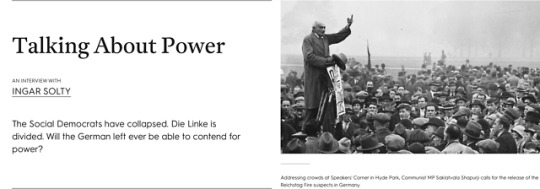
JACOBIN MAGAZINE
For all its economic might, Germany’s main centrist parties are in crisis. If barely a decade ago the Christian Democrats (CDU) and Social Democrats (SPD) conquered over three-quarters of the vote, in polling today they represent under half of the electorate. But as the main parties lose their hold over Germans, the Left does not seem well-placed to take advantage. The Die Linke party formed by postcommunists and a split from the SPD in 2007 has secured a respectable vote nationally and at the regional level, becoming the country’s fourth-largest political force, and yet has consistently failed to rise above 10 percent of the vote. Indeed, the real upstarts in German politics today are the far-right Alternative für Deutschland (AfD, the first such party to reach parliament since 1952) and the liberal-ecologist Green Party.
Seeking to break out of this strategic impasse, some leading figures in Die Linke have created a new populist movement designed to reinsert the language of class and poverty into German politics and split the AfD’s own base. However, this remains controversial within Die Linke, with figures loyal to party co-chair Katja Kipping accusing Aufstehen’s frontwoman Sahra Wagenknecht of kowtowing to anti-immigration sentiment.
In this second part of an interview originally conducted for Novosti, Jerko Bakotin spoke with researcher Ingar Solty about the decline of social democracy, Die Linke’s strategic dilemma, and the possibility of building a counter-hegemonic force able to challenge for power.
Jerko Bakotin:
The German Social Democrats (SPD) are at a historic low. The Greens are on the rise, but critics claim that this is now a solidly pro-business party. And to their left, Die Linke is unable to break into double figures in the polls. If there has often been talk of a future “red-red-green” government uniting all three parties, this is today arithmetically impossible. So how would you describe the Left’s perspectives today?
INGAR SOLTY:
Ever since the creation of Die Linke [in 2007, uniting the postcommunist Party of Democratic Socialism with a split from the SPD] the spoken or unspoken aim of the German left was to create an anti-neoliberal reform government together with the Greens and SPD. If for these other parties forming a government is itself the end goal, for Die Linke this would be what Rosa Luxemburg called a transitional goal of revolutionary realpolitik. That is, a move that improved conditions in the fight for a postcapitalist society. Such a coalition would of course require that the SPD broke with its Third Way, market-oriented neoliberal policies; the Greens, similarly, would have to turn away from market-based pseudo-“solutions” to the ecological crisis like carbon emission trading, and indeed their complete surrender to the car industry in the state of Baden-Württemberg, where they are the dominant political force.
Today “red-red-green” is impossible — for political reasons and, with the erosion of social democracy and the rise of the far right, even arithmetically. The SPD is incapable of renewing itself. Its leaders simply cannot turn around and say “Look, everything we ourselves did since at least 2002 was a total mistake and we will have to undo everything that we have done ever since.”
Yet while they cannot say this, doing so — and following up on it with concrete policies significantly improving workers’ lives — is a necessary step toward regaining some credibility.
Jerko Bakotin:
What chance is there for a radical shift within the SPD, like in the cases of Jeremy Corbyn’sLabour Party or indeed Bernie Sanders’s 2016 primary campaign?
INGAR SOLTY:
There are no such leaders on the horizon — and there will not be a Sanders or Corbyn within the SPD. This first owes to Germany’s different political economy. In the US and UK we see deindustrialization, the decline of labor unions, and tuition fees being offloaded onto workers, whereas Germany still does have a strong industrial base with relatively strong labor unions. Taken together with the existence of a vocational training system for manual laborers and the fact that higher education for intellectual workers is tuition-free, these factors still guarantee “middle class” status for a significant share of the professional working class. This major difference makes the US and Great Britain politically more comparable to Spain, Italy, even Greece and Portugal, in the sense that while in all those countries, the erosion of the working “middle“ classes is already a fact; in Germany it is merely feared.
It seems that real immiseration facilitates left-wing responses, whereas the fear of immiseration produces conditions for right-wing ones. And that’s why, so far, the richer, more industrialized northern European countries have seen the far right benefitting more from the global financial and eurozone crisis than the Left, while the opposite is true in the European Union’s (southern) periphery, in Britain and, at least potentially, in the US, where Sanders would probably have won against Trump, had it not been for the Democratic establishment’s machinations, and in Britain where we’re close to a Corbyn government. (Italy could be a counterargument to this thesis, but the Five Star Movement predominantly received its votes with left-wing demands and from former left-wing voters.)
The second reason why there is not going to be a Sanders or Corbyn type in the SPD is that it has been in government for sixteen of the last twenty years. Germany has proportional representation instead of a US- or UK-style first-past-the-post electoral system, and this has allowed smaller, more consistently left-wing parties like Die Linke to establish themselves electorally. For sure, there are still some really well-meaning social-democratic leftists inside the union movement and even the SPD’s formally independent Friedrich Ebert Foundation and such like, but all the Corbyn and Sanders-types were already shed to Die Linke years ago.
There are no left-wing backbenchers in the SPD like Corbyn in Britain, who voted against pretty much everything New Labour did, in domestic as well as foreign policy. If some did remain, they left recently, like Marco Bülow, who described himself as completely isolated among SPD parliamentarians, or the young party intellectual Nils Heisterhagen who was ousted from his position after he had demanded a stronger class-based political orientation in his book The Liberal Illusion. And of course, what kind of sane anti-neoliberal and peace-oriented leftist would have joined or stuck with a hawkish neoliberal and imperialist SPD even over the last twenty years?
All the new cadres the SPD has attracted over that period have an utterly technocratic understanding of politics. While the ongoing class war from above demands massive social mobilizations from below, akin to the yellow vest protests in France or the kind of movements that Bernie Sanders is promoting, these SPD leaders do not know any form of politics other than working pragmatically within institutions that have long turned against the interests of their party’s former working-class base. They do not know how to do anything except governing under and with the powers-that-be. There is no reason to take cheer from this; the erosion of social democracy is a tragedy, because it is largely the far right and not the Left filling the vacuum.
(Continue Reading)
19 notes
·
View notes
Link
With the National Council for Peace and Order (NCPO) slowly but gradually lifting restrictions on campaigning, scores of new political parties have stepped into the fray. Careful not to run afoul of the recently revised and tightened organic law on political parties, they are making sure their steps are in sync with the slow pace set by the junta. For over four years, Thais have patiently waited to cast their ballots, and parties are keen to stay qualified for the long-awaited game of musical chairs.
Among the new parties, two appear to represent the coming of hope, even for the impatient and the disillusioned—the Future Forward Party and the Commoners’ Party. Both cater to distinctive constituencies. Together, they present a sort of contradictory complementarity much needed in Thai politics.
(I note inconsistency in how English-language media spell the latter. While the Thai word samanchon is singular, independent media including Prachatai and The Isaan Record translate it as plural. By contrast, there is no consensus in mainstream media. Whereas Khaosod English uses the adjectival form—the Commoner Party—the Nation confusingly employs both the adjectival and plural forms. Here, I follow the usage of independent media outlets.)
Future Forward—whose future?
The Future Forward Party is led by a group of upper-middle and middle-class urbanites, scholars and activists, who previously played commentator roles from the periphery but appear now tired of second-hand democracy. Thanathorn Juangroongraungkit—a son of the Thai Summit family, which controls the biggest automobile company in Thailand—heads the party, now one of the most followed on social media. Future Forward presents itself as the third force, or a remedy to polarised politics.
Thanathorn is more than meets the eye. Despite his wealth, he has long been active in Thai progressive circles and is well known for his left-leaning ideals. Thanathorn’s politics crystallised during his period of student activism as the vice-president of Thammasat’s Student Union and the deputy-secretary of the Student Federation of Thailand. Regularly making rounds in Thai social media is a photo of Thanathorn caught between the police and the Assembly of the Poor, a front-page moment and a good caricature. In many ways, he represents the contradictions reshaping Thai contemporary politics.
The Future Forward Party is well positioned to tap into pro-democracy factions that shun Thaksin’s party line, including independent labour unions in metropolitan areas. He is aided by many progressive scholars and leftist activists including Piyabutr Saengkanokkul—an active member of Nitirat, a group of politically-critical legal scholars—and Sustarum Thammaboosadee, a committed advocate of the welfare state. Both are foreign-educated, young professors at Thammasat University. Thanathorn and his team have been well received even by mainstream media.
But Future Forward may only be a case of Thai urban, organised labour being left with the “lesser of two evils”: token representation. As the leftist scholar-in-exile Giles Ungpakorn comments, the Future Forward Party “is likely to be a party aimed at sections of the pro-democracy middle classes. It will prioritise the free-market and business interests while also claiming to support the poor in an abstract manner. Its leader, tycoon Thanathorn Juangroongruangkit, has stated that it will ‘protect capitalism for the benefit of the majority’. In the past, he has emphasised that business must make a profit before benefits for workers can be improved.”
Future Forward may offer a way out of military dictatorship, yet it is hard to imagine a set of coherent policies that is simultaneously laissez-faire and pro-labour, not to mention inclusive of meaningful power-sharing with the working class. Previously a lecturer at Thammasat myself, I share much of my background with the two scholars who support Thanathorn in moving the Future Forward. Nevertheless, as a labour advocate, I grapple with the contradictions between the party’s class interests and pro-labour claims.
The Commoners’ Party
In my view, the advent of the Commoners’ Party represents a more exciting, radical break with the status quo—one that has so far kept class privilege of the likes of Juangroongruangkit intact.
Contrary to the Future Forward’s elitist, think-tank style, the Commoners’ Party sets out to be governed by the working poor. Although some co-founders are from urban middle-class backgrounds, the party’s identity is shaped by shared concerns around the poor’s lack of power and the destructive impacts of uneven development in the Northeast—a region of origin for many activists.
Against the backdrop of hierarchical politics commonplace in Thailand, the Commoners’ Party has pledged to be truly bottom-up and build policies from the ground—an ideal I wholeheartedly support though follow with baited breath. Unlike Future Forward which centres on leaders’ charisma and grand ideas, the Commoners’ premise is to create a genuine platform for the voices of villagers, hitherto silenced or non-existent in parliamentarian politics. The party itself grew out of a grassroots movement that bears the same name comprising political activists and NGO workers from various right-based issues.
Despite state surveillance and restrictions on campaigning, the Commoners’ activists have been organising forums across the country to provide a platform for locals to voice concerns over various issues including communal rights and environmental justice. Early this year, the party led a group of protesters in marching over 450 kilometres to help shed light on neglected but crucial issues of food security and community control over natural resources. Most importantly, it may be the first time since the heyday of the 1970s student uprisings that a Thai political party has explicitly discussed social-democratic policies.
Having known the Commoners’ founders and some of its activist members myself, I cannot deny that the transition from a social movement to fully-fledged political party is full of contradictions: here comes to mind the image of a banner with an anarchist symbol that decorated the site of the party’s first general meeting in late September 2018. According to the Party’s elected chief Lertsak Kamkongsak, the activists have taken inspiration from a number of sources: Western-style green parties, eco-socialism, anarchism, European Pirate Parties, and the indigenous Zapatista group. The idea of creating a political party was entertained for years by a co-founder and the secretary-elect of the Commoners’ party, Kittichai Ngamchaipisit—a veteran peace activist and strategist who is personally drawn to Gandhi’s philosophy of non-violence and the Zapatistas’ style of direct democracy.
Soon after the Commoners’ first general meeting, the party was forced to face reality. It was struggling to meet the legal requirements of having a million-baht initial fund and five hundred members. Yet the Party has finally overcome the hurdles, having a first taste of what it’s like to play this electoral game.
The Commoners’ activists may be new to elections, but they are not to street politics and building grassroots movements. Lertsak has years of experience in organising with communities resisting extractive mining and dam projects. The trust bestowed on him testifies to the underlying issues important to his constituency: social inequality, economic exploitation, environmental degradation, and the marginalisation of the rural poor in the political process. In this sense, the Commoners’ Party embodies undercurrent ethno-regional and class indignations suppressed over several decades of uneven development.
These are, of course, crucial concerns shared also by red shirt supporters. But within the proxy war of rival elites, these issues have not only been unaddressed, but aggravated by competing populism.
A Commoners’ Future?
Despite my excitement and optimism, realistically the Commoners’ and Future Forward parties are and will be a minority in Thai politics. This realisation makes the idea of working together imperative. Yet according to Kittichai, regrettably irreconcilable differences between the Commoners’ and Future Forward foreclosed the prospect of merging the two.
I join other activists from the left who are suggesting that the two parties collaborate. That collaboration would need to take power differentials into serious consideration. What the Commoners stand for—the interests and livelihoods of their poor constituency—sit uneasily with the privileged positions of Future Forward’s supporters.
Given that their target constituencies would be mutually exclusive, the least the two parties could do is to endorse each other’s candidates. They could also make sure that their platforms do not compete, or cancel each other out. Apart from shared anti-coup sentiments, there are a variety of concrete issues they could jointly discuss ranging from downsizing Special Economic Zones, strengthening universal health care, advancing the idea of welfare state through progressive taxation, as well as land reforms and a living wage.
Both parties have their own strengths, which are variously oppositional and complementary: one pushes for change from above, the other from below. While Future Forward is well endowed with financial and social capital, as well as a well-versed network of scholars, the Commoners have deeper understanding of uneven development and how to work with the masses beyond the ballot.
15 notes
·
View notes
Note
how can people within europe can help catalonia? letters? protesting? i wish i could help from britain but i feel like i can do nothing
hello! i’m so sorry it took me so long to answer
first of all thank you very very much for your interest. it’s very important for us to have allies in other countries, because we will need you to help us.
some months ago I made this post (http://useless-catalanfacts.tumblr.com/post/165972530938/how-can-you-help-catalonia) and some things have changed, but most still aplies. I’ll paste what still applies and update it here:
Here’s a little list of how you can help us Catalans from outside Catalonia!
1. Stay informed and talk about it with your friends.Spread the word, amplify our voices. Let the world know that human rights are been violated against the Catalan people. You can read trustworthy news in English on Col·lectiu Emma’s website (they’re a non-profit org that works to tell the world the situation of the Catalan people), and the newspapers Vilaweb and CataloniaToday.
Share information about what’s going on on your social media, so more people can see it.
Here’s some Facebook pages in English (some of these sometimes post in other languages as well): ANC USA / ANC England / look for ANC + your own country or city, Col·lectiu Emma, Americans for Catalonia, Vilaweb News from Catalonia in English, Catalan News.
Twitter: ANC International, Catalan News, Col·lectiu Emma, Vilaweb English.
2. Send letters to the political prisoners or those on exile. They’ve been there for months and have expressed many times how encouraging letters are what keeps their hopes up in their hard situation, and since they aren’t allowed internet nor anything like that in jail, letters are their only way of communication. I’m sure that getting a letter from someone from outside Catalonia will make them very happy. Learn more about the prisoners in the website Us Volem a Casa (in English, Spanish, and Catalan)
Here are their addresses in jail. It’s very important that you write your whole return address and that you don’t include anything more than paper inside the envelope, because the jail staff uses any minimal opportunity to not deliver them their letters.
Jordi Sànchez i PicanyolCentre Penitenciari Lledoners: Mòdul 2C-55, km 37,08250, Sant Joan de Vilatorrada (Bages).
Jordi Cuixart i NavarroCentre Penitenciari Lledoners: Mòdul 2C-55, km 37,08250, Sant Joan de Vilatorrada (Bages).
Carme Forcadell LluísCentre Penitenciari Mas d’Enric Mòdul de donesTravessia Comella Moro,1543764 El Catllar
Josep Rull i AndreuCentre Penitenciari Lledoners: Mòdul 2C-55, km 37,08250, Sant Joan de Vilatorrada (Bages).
Jordi Turull NegreCentre Penitenciari Lledoners: Mòdul 2C-55, km 37,08250, Sant Joan de Vilatorrada (Bages).
Raül Romeva RuedaCentre Penitenciari Lledoners: Mòdul 2C-55, km 37,08250, Sant Joan de Vilatorrada (Bages).
Dolors BassaCentre Penitenciari Puig de les Basses: Mòdul de dones.Raval disseminat, 53,17600, Figueres (Alt Empordà).
Oriol Junqueras i ViesCentre Penitenciari Lledoners: Mòdul 2C-55, km 37,08250, Sant Joan de Vilatorrada (Bages).
Joaquim Forn i ChiarielloCentre Penitenciari Lledoners: Mòdul 2C-55, km 37,08250, Sant Joan de Vilatorrada (Bages).
3. If you can, consider donating to the main non-profit organisations fighting for the rights of Catalan people and the liberation of the political prisoners.
Òmnium Cultural: an independent organisation that since 1961 has helped to promote the Catalan language and culture (even during the dictatorship, when Catalan was strictly banned! These people have done A LOT), social cohesion, and these last years have leadered the independence process. Their president, Jordi Cuixart, is imprisoned by the Spanish government in Madrid since October 2017, without a trial, and only for having organised a peaceful protest. Click here to donate. The website is in Catalan so I can guide you throught it: you have to write the amount of euros you want to donate and click “següent” (“next”) and fill up your details (you can use google translate).
Assemblea Nacional Catalana (ANC): the most important pro-independence organisation. Their president, Jordi Sànchez, is also imprisoned under the same circumstances as Òmnium’s president. Together with Òmnium, they have been organising the protests, informative talks, prepared a lot of things to make sure everybody could vote in the referendum, pressuring politicians to listen to the people, etc. They have hundreds of volunteers in every area. Definitely the best pro-independence organisation. To donate, pay in what you want in the account number you can find in their website.
Association of the families of the political prisoners: the prisoners are kept in Madrid, far away from Catalonia, which prevents their relatives from being able to afford to visit them on the jail’s visit days. The relatives have organized in an association called Associació Catalana pels Drets Civils. All the donations go to paying for the travel expenses to visit their relatives in jail or exile from time to time, and a smaller part to providing for the prisoners’ children in the cases where they can’t live with only the salary of 1 parent. For international donations, this is their bank swift code: CDENESBBXXX. And inside Spain’s borders it’s ES71 3025 0001 1814 3359 2190.
Plataforma per la Llengua: an NGO that works to promote the Catalan language. They do a great job in helping immigrants learn the language and get more integrated, and also help older people (who were raised during the dictatorship and so can’t write/read their mother language) learn Catalan. This is not directly linked to the politics you’ll hear about on TV, but after 300 years where Spain has been constantly trying to suppress our language, still speaking it is a revolutionary act. And it makes the fascists angry. Here to donate.
4. Get organized. Check out if there’s an ANC or CDR organization in your country, city or region, and get in touch with them. Volunteer if you can, or sign up to known when they’re planning events so you can help or at least attend.
In your case, anon, since you’re from the UK maybe there’s events you can attend to support Clara Ponsatí, one of the exiles who is in Scotland.
5. Send letters to the European leaders and ask them to make a move. The European Union shouldn’t allow one of its member states, Spain, to commit such human rights violations. In this PDF, made by Associació Catalana pels Drets Civils, you will find example letters you can use written for each leader in their country’s language. Here’s some addresses:
Bundeskanzleramt BundeskanzlerinAngela MerkelWilly-Brandt-Straße 110557 BerlinGermany
Excm. M. Emmanuel MacronLe Palais de L’Élysée55, Rue du Faubourg Saint-Honoré75008 ParisFrance
Kunnioitettu Pääministeri Juha SipiläValtioneuvoston kansliaSnellmaninkatu 100023 HelsinkiFinland
Excm. Mr. Leo VaradkarDepartment of the TaoiseachGovernment BuildingsUpper Merrion Street, Dublin 2,D02 R583Ireland
Exc. O senhor António CostaRua Imprensa à Estrela 61200-619 LisboaPortugal
Please, send them to your own country’s president and foreign affairs minister/secretary as well.
6. The most important one: when the times comes, pressure your governments to recognise the Republic of Catalonia.
Thank you very much again for your interest! 💕
#sorry i just saw the ask now but it's probably been some days#i'm in finals week and the blog is running on queue#ask#anonymous#actualitat#catalonia#catalunya#solidarity#political prisoners
68 notes
·
View notes
Text
How to Start a Business in Spain
Essential steps, tips and practical advice to start a business in Spain.
In this article we will focus on the practical aspects of commissioning a business in Spain. However, we assume that before you start your business in Spain you need to know the legal requirements:
You already have a solid business idea;
You have done enough market research to confirm the economic viability of your proposed business (if you don’t know how, I recommend that you buy a book on the subject or hire a consultant);
Ideally you have prior experience in the industry you aspire to;
Speak Spanish fluently, or have a business partner who speaks Spanish fluently.
Steps to start a successful business in Spain.
Please note that the information contained here in “Starting a Business in Spain” is only a guide and should not replace the professional advice of a lawyer, manager, business consultant, accountant and / or financial advisor. I encourage you to befriend these professionals early in the startup process.
To start a business in Spain follow the six essential steps
Choose a name for your business (and register it).
Choose a legal business structure.
Create a business plan.
Find financing.
Find a suitable location for your premises.
Obtain secure licenses and permits.
1. Choosing a name for your business
A good business name is the first asset of your company in Spain. You can choose to register your business name, which in theory gives the name holder the exclusive right to use that name for commercial purposes. The registration of the commercial name is optional and is managed by the Spanish office of the patents and brand.
In Spain, the companies of the company may have a brand or trade name different from their official trade name. See Companies in Spain: Types of Business Entities for Companies in Spain.
2. Selecting a legal business structure
Spain offers various business legal structures, also known as business entities, to meet a variety of needs, each with a different set of legal and tax responsibilities. Choosing the right one is important to accommodate the present and future goals of your future business. The legal business structures in Spain are as follows (links that take you to the corresponding bit on our Companies in Spain page: Types of Business Entities for Companies in Spain):
Sole Trader or Sole Owner (Individual or Autonomous Entrepreneur)
Mixed company (Community of Assets or CB)
Civil society
Sociedad Anónima or SA (Public Limited Company)
Sociedad de Responsabilidad Limitada, SRL (Sociedad de Responsabilidad Limitada, SRL)
New Enterprise Limited Company
Labor Company (Labor Society)
Collective society
Limited Partnership
Cooperativa (Cooperative Society)
3. Creating a business plan
Whether it’s to attract investors or to create a roadmap for growth, every business needs a business plan. Any good business start-up book should contain a chapter that outlines the essential elements of a good business plan, but here is one of those outlines of the elements of a business plan. However, there are two additional things to keep in mind in Spain:
Idiom. If you plan to seek Spanish financing or investors, your business plan needs to be in Spanish. On the other hand, if you plan to seek a mix of Spanish and international investors, you should have a Spanish and English version of your business plan available to everyone involved.
Getting help. Local Chambers of Commerce in Spain offer free advice and support to entrepreneurs. Find a Chamber of Commerce in your area.
4. Looking for financing
Proper trade financing is key to any business, so don’t rule out any options just yet, including the following:
Personal Financing
Especially for small businesses that don’t require a lot of capital, dipping into your savings (or asking for gifts or loans from friends or family) might be the shortest and best route to start your business.
Loans (Loans)
Available to residents and non-residents alike, loan terms vary depending on the size of the loan required (or whether it is considered a microcredit), the amount of the collateral, the financial institution, and other factors. You may be required to repay the loan in as little as three years, or in some cases up to fifteen. Payments can be monthly, quarterly or semi-annual. Consult with the ICO (Official Credit Institute, in English and Spanish) or with any bank (bank) or savings bank. Make sure you go shopping.
Subsidies (Subsidies or Aids)
The grants are available to new and existing companies at the municipal, provincial, regional, national and European Union levels. Grant terms vary widely, but grants are often available to businesses in certain industries or sectors, creating jobs in certain areas, or employing certain disadvantaged populations.
Check with your municipal, provincial, and regional government, or local Chamber of Commerce, for available grants. Consult the Spanish subsidies in the DGPYME (General Directorate of Small and Medium Enterprise Policy).
Business Angels
Business Angels are private investors who invest in new or existing businesses for a variety of personal or financial reasons. But angel or not, business angels expect a good return on their investment like any financial institution. The advantage of an angel investor is that investment conditions and the amount of risk they are willing to take vary widely. Sometimes when a bank turns you down for a loan, an angel investor may come to your rescue. Check with the Spanish Network of Business Angels.
Lines of Credit (Credit account or credit policy)
A line of credit during the start-up phase can be considered a peace of mind loan for those unforeseen extra costs (which will be there and you must plan, by the way). You pay interest on borrowed money when you need it, and a commission for the privilege of having a line of credit when you don’t need it. Interest rates can be fixed or variable and the terms are usually one year.
5. Finding a suitable place for your business
Once you have considered who your customers are, where they will come from, what type of facilities will you need to accommodate your business (for example, will you need dressing room space? Will you need a warehouse? Do your delivery drivers need parking? Being close to certain other types of businesses, then you can start looking for a location for your business.
Walk around your area and look for signs like “transfer,” “for rent,” “space available,” and so on. Write down the phone number and call them. Or use an experienced local real estate agent. Or try a website like Fotocasa. es, which offers a list of offices and commercial premises throughout Spain for rent, rental or purchase.
6. Licenses, permits and insurance
You will need licenses and permits from your respective municipal and regional governments. Check with your local council and autonomous community for the latest requirements.
To get an idea of what may be necessary, in the city of Madrid for example, you must obtain a license (planning license) if you intend to build, renovate or demolish anything (interior or exterior) where your business will be developed . (You won’t need a license if you just want to paint the interior or change something small inside your unit. License fees vary depending on exactly what you are doing and how many square feet you are doing it.
At the regional level in the Community of Madrid, certain business activities are required to obtain specific activity licenses, such as travel agencies, tattoos, body repair shops, etc. Some licenses for which you will have to pay a fee.
Depending on what your proposed business is, other types of licenses may be required as well.
It is not a license per se, but you must also be prepared to collect Value Added Tax (VAT), which ranges from 4 to 21%. Tax rules are governed by different plans (regimes) depending on your business. Check with the National Tax Agency and your tax or financial advisor on your tax and reporting obligations.
Your business will also need a “Visitors Book” (Guest Book). You must acquire it from the Provincial Directorate of the Ministry of Labor and Social Affairs of your province and have it available at all times for labor and Social Security inspectors.
Once you have successfully chosen a name and legal structure for your business, created a business plan, found funding and a location, and obtained licenses and permits, then you can start hiring employees, creating a website, advertising and perform all other tasks that will contribute to the success of your own Spanish business.
Self Employed / Investor Visa (Self Employed Visa)
It may be possible to obtain a work visa based on opening a company in Spain. However, among other things, you will have to demonstrate that the company will be able to help you after deducting the costs of the company, that you are able to do whatever it is you intend to do in Spain and that you can finance the proposed company. You must also apply for the visa in your home country.
La entrada How to Start a Business in Spain se publicó primero en ᐅ My Access Florida – You Login to Access Florida ✅ ☎.
from WordPress https://my-access-florida.com/how-to-start-a-business-in-spain/
0 notes
Text
MYANMAR - A FASCISTIC-TYPE IDEOLOGY AND ITS MANIFESTATION

General Min Aung Hlaing. Image courtesy Ye Aung Thu/AFP via Getty Images, and Foreign Policy.com
For as long as the current generation of People in Myanmar can recall, the Tatmadaw, or armed forces have always preferred to remain outside the barracks rather than within. It should not surprise anyone then, that the military stepped in once again on Feb 1, 2021 following upon a general election which was comfortably secured by the National League for Democracy and led by Nobel Prize laureate, Aung San Suu Kyi. (1) The junta leader, General Min Aung Hlaing declared that the Tatmadaw will construct a “true and disciplined democracy.” A contradiction in terms surely. Soon after this illegal seizure of power, the Tatmadaw, as expected, violently suppressed demonstrators on the streets of Mandalay, Yangon and other major cities. (2)
It seems Myanmar’s experiment in democracy has come to an end, again. A tragedy no doubt, as reported by the New York Times. (3)
The seizure of power in Myanmar is quite possibly a symptom of a larger, and underlying problem in the country, and which is also existing or recurrent in most countries of South-East and North-East Asia – its political ideology. Try setting up a chamber of commerce consisting of business people to promote their common interests, in any country in the region and one will be received with a red carpet, cushioned with tax incentives at public expense. But should anyone attempt to set up a trades union to further the interests of workers, farmers or the masses, it is quite possible that person will be unceremoniously hauled to jail. Whether it is class or caste, it is the same thing. The upper class or caste must have its publicly-subsidized privileges. Hence, their “democracy,” if at all, must be disciplined. Not that they are unaware that democracy without pluralism is by any account, a contradiction.
The following table, adapted from the international human rights organization, Freedom House, offers a glimpse of the state of human rights and dignity in the region. (4)

The table raises serious questions. Chief among these is the ideological basis for retaining or advocating a repressive political system of power in the countries, including Myanmar’s. This requires careful and scholarly analyses, of which there are doubtless many. However, a comparative and historical analysis of the political systems in the region with a view to identifying common features, may offer clearer insights into the dynamics and political culture of the ruling classes. It is hoped scholars will attend more earnestly to this in the future.
In my exploration of this essay, it occurred to me, quite naturally, to have a working definition, including the features, of fascism. A summary, prepared by Robert Soucy offers a good start. (5) There seems to be common threads in his definition/features, and the observed practices of the repressive political systems in the Asia-Pacific. I like to share selective excerpts of Prof. Soucy’s summary to reinforce this statement. I should caution our readers that Prof Soucy’s summary dealt in most part with the origins and rise of European fascism, especially after WW1 :
Extracts
1. “Although fascist parties and movements differed significantly from one another, they had many characteristics in common, including extreme militaristic nationalism, contempt for electoral democracy and political and cultural liberalism, a belief in natural social hierarchy and the rule of elites, and the desire to create a Volksgemeinschaft (German: “people’s community”), in which individual interests would be subordinated to the good of the nation.”
2. “However, the economic programs of the great majority of fascist movements were extremely conservative, favouring the wealthy far more than the middle class and the working class. Their talk of national “socialism” was quite fraudulent in this respect.”
3. “The fascist economic theory corporatism called for organizing each of the major sectors of industry, agriculture, the professions, and the arts into state- or management-controlled trade unions and employer associations, or “corporations,” each of which would negotiate labour contracts and working conditions and represent the general interests of their professions in a larger assembly of corporations, or “corporatist parliament.”………. In practice, fascist corporatism was used to destroy labour movements and suppress political dissent.”
4. “Fascists defended the Führerprinzip (“leadership principle”), the belief that the party and the state should have a single leader with absolute power.”
5. “Fascist educators emphasized character building over intellectual growth, devalued the transmission of information, inculcated blind obedience to authority, and discouraged critical and independent thinking that challenged fascist ideology.”
6. “In 1934 Ernst Röhm, leader of the SA, worried that Germans had “forgotten how to hate.” “Virile hate,” he wrote, “has been replaced by feminine lamentation. But he who is unable to hate cannot love either. Fanatical love and hate—their fires kindle flames of freedom.” De Jouvenel agreed: “Any sentiment less vigorous than hatred indicates a lack of virility.”
The foregoing extracts are illuminating in so far they help us to appreciate the totality of fascism. World War 2 and the enormous suffering and sacrifices which defined it, was no accident. As we observe today the dimming of a semblance of democracy in Myanmar, we may also recall that the writing was already on the wall in 2017 when the Rakhine state in Myanmar was wrecked by violent turmoil, leading the United Nations Secretary General, Antonio Guterres to describe “the violence as ethnic cleansing…” by the Tatmadaw against the minority Rohinyas. (6)
Burmese nationalism, fronted by the Tatmadaw, is in reality an ongoing exercise to privilege an entrenched few, through systemic control and pacification of a population by coercive means. In tandem with this is the promotion of an ideology of uniformity, undergirded by a martial spirit. One only needs to observe the national or independence day celebrations in China, Myanmar, N.Korea, Vietnam, Indonesia and Singapore (7,8, 9,10,11,12) to appreciate the dominant role the military or security apparatus exerts on nation-building. Many of these countries have a history of ethic cleansing and or political repression and re-education against their minority ethnic and dissident groups.
As long as the international community, through its organ, the United Nations International Organization, goes on giving official recognition to repressive regimes, real and positive change will remain elusive. As these regimes become entrenched within the structures of the state, their ambitions will grow and may pose serious threats to global security and peace, as Mussolini and Hitler proved nearly a century ago. Xi’s China is possibly illustrative today. One party rule will always be totalitarian, however one cuts it. The Tatmadaw in Myanmar is another manifestation of that.
Sources/References
1. Myanmar coup: What is happening and why? - BBC News
2. Myanmar: End Lethal Force Against Protesters | Human Rights Watch (hrw.org)
3. Videos Show Extent of Myanmar Military’s Bloody Crackdown - The New York Times (nytimes.com)
4. Countries and Territories | Freedom House
5. Soucy, Robert. Professor Emeritus of History, Oberlin College
fascism | Definition, Meaning, Characteristics, Examples, & History | Britannica
6. What Forces Are Fueling Myanmar’s Rohingya Crisis? (cfr.org)
7. In Pictures: China’s National Day Parade Features Pomp and Artillery - The New York Times (nytimes.com)
8. 71st anniversary of Myanmar's independence ceremony celebrated in Nay Pyi Taw - Xinhua | English.news.cn (xinhuanet.com)
9. North Korea celebrates 70th anniversary with huge parade (nbcnews.com)
10. Vietnam holds meeting, military parade to celebrate National Day | Hightlight news, Stories from Vietnam and the World (vir.com.vn)
11. Independence Day Celebrations in Jakarta (jakartaglobe.id)
12. Soldiers salut from their military vehicles during the 54th National... News Photo - Getty Images
0 notes
Text
Biden Throws Gasoline on Ukraine Conflict
TLOS ANGELES (OnlineColumnist.com), March 6, 2021.--one deaf to the concept of linkage, 78-year-old President Joe Biden and his 58-year-old Secretary of State have pushed Ukraine into a new crisis in the restive Donbass region of Southeastern Ukraine near the Russian border. Biden and Blinken surely knew that when they sanctioned Russia for it’s treatment of 44-year-old dissident Alexi Navalny, it would create problems for Ukraine in the Russian speaking territories AKA the Peoples Republic of Donetsk where Uranian and Russian troops have been battling since before Russian President Vladimir Putin seized the Crimean Peninsula March 1, 2014. Putin’s mindful of Russian enclaves in the wreckage of the former Soviet Union, where populations now identified as Ukrainian actually hade loyalty to the Kremlin. Biden and Blinken decimated any attempt at diplomacy with the Russian Federation, slapping Kremlin officials with new sanctions March 2.
What were Biden and Blinken thinking when they allowed Russian internal affairs to damage U.S. national security, and now, Ukrainian sovereignty? Sanctioning the Russian Federation over a known Trotskyite who has plotted to overthrow the Russian government makes it look like the U.S. and European Union want Putin out. But knowing the chickens come home to roost with more skirmishes on the Urkaine-Russian border. Kremlin Spokesman Dmitry Peskov said the Ukrainian forces have escalated the shelling around Russian enclaves in Southwest Ukraine. Peskov said Ukraine breached the fragile ceasefire agreement. “We also hope all our partners . . . will pay attention to the growing tension on the contact line and will use their influence to prevent this escalation from crossing a dangerous line,” Peskov said, asking France and Germany to help restrain Ukrainian forces from starting another war.
Since 2014 over 14,000 civilians have died in hostilities between Ukrainians troop and pro-Russian forces seeking independence from Kievy. When a CIA-backed Feb. 22, 2014 coup toppled the Kremlin backed government of former Ukrainian President Viktor Yanukovych, Putin sat helplessly by hosting the Sochi Winter Games. Once the Games ended Feb. 23, it took Putin one week to invade Crimea and reclaim the territory from Ukraine. If Biden and Blinken really wanted peace in Ukraine, why would they sanction Putin over Navalny, a know revolutionary who gaslights the West to think he leads a pro-democracy movement. Navalny once called Chechens “cockroaches,” saying the situation with Chechens can only be resolved with a “psistol.” Amnesty International felt so strongly about Navalny’s past racist comments, that they revoked his “prisoner of conscience” status.
Biden and Blinken’s blunder sending U.S.-Russian relations to Cold Ward lows shows he’s no fit for the job of commander-in-chief. Biden’s old ties with Ukraine through his 50-year-old son Hunter makes it difficult for him to manage any decisions without a conflict of interest. Joe landed Hunter a cushy job at a corrupt Ukrainian energy company Burisma Holdings, making him millions of dollars. When it comes to new tensions on the Ukraine-Russian border, Biden has no leverage with the Kremlin because he’s imposed new sanctions. Putin knows exactly how far to push an escalation into hostilities with Ukrainian officials. People’s Republic of Donetsk authorized its Russian-backed forces to respond to Ukrainian shelling, warning of a dangerous escalation. Ukraine’s 41-year-old President Zolodymr Zelensky signaled that Ukrainian forces would fire back at Russian-backed shelling.
Loenid Kravcuk, firs president of Ukraine and head of the country delegation to the tri-lateral contact group with Russia and the Organization for Security Cooperation in Europe [OSCE] would return fire on Russian-backed forces. Kravchuk said Ukrainian forces would respond to Russia troops “symmetrically,” firing back when provoked. If Zelensky pushed too hard firing on Russian or Russian-backed troops, Putin could seize the Donbass region or Donetsk for the Russian Federation. If that happened, what would Biden and Blinken do then? We know what Biden and his boss former President Barack Obama did March 1, 2014 when Putin seized Crimea. Obama and Biden did nothing militarily to reclaim Ukrainian territory. Ukraine, under 55-year-old former Ukrainian Petro Poroshenki, talked tough but did nothing to reclaim lost territory seized by Putin annexing the Crimean Peninsula.
Biden and Blinken burnt their bridges with Putin, sanctioning the Kremlin after Navalny’s sentencing for two-and-a-half years in a Russian penal colony. Biden and Blinken were willing to toss out years of hard-fought diplomacy during the Trump administration. When Obama and Biden left office Jan. 20, 2017, U.S.-Russian relations were at the lowest point since the 1962 Cuban Missile Crisis. Trump did everything possible to restore good relations with Russia. Congress accused Trump and his inner circle, including 62-year-old Lt. Gen. Michael Flynn, of colluding with the Kremlin, when all they did was try to improve U.S.-Russian relations. If Biden wanted to get along with Russia, he would have not sanctioned the Kremlin over Trotskyite Alexi Navalny. Navalny’s got his own agenda and network of revolutionaries seeking to overthrow Putin’s 20-year reign of power.
About the Author
John M. Curtis writes politically neutral commentary analyzing spin in national and global news. He’s editor of OnlineColumnist.com and author of Dodging The Bullet and Operation Charisma. Reply Reply All Forward
0 notes
Text
PRID ZABIJAT NA VYJEBANU SLOWAKIJU!!! ZASEKNUTA V CHUDOBE!!!
Miss. Antónia Ficová,
Hažín nad Cirochou č. d. 181,
district of Humenné,
Slovak Republic,
European Union, 067 83
+421 918 216 381
To date October 31, 2016
International Court of Justice,
Peace Palace, 2517 KJ The Hague
The Netherlands
Subject:
Complaint on instruments, method´s and approach of Slovak Government and their representatives since Octobet 2012
First of all, the reasom why I have decided to inform you directly is following: providing false statements on my behalf, restrictions, limitations, barriers, controlling, hiding true facts and data, false fiances, managed bankruptcy, opportunity cost, betrayal, etc.
Secondly, take into your consideration that this open letter, complaint, honest statement should be treated with high level of professionalism and strong ethic´s rules with an appropriate action for my personal improvement since no change has been done.
In sum, I will use level of langugae and style for your better understanding since people are not used to accept me or support me for who I am. In other words, issues like religions, status, male/female, activities, performance, income, social and financial situation, health, after my graduation in July of 2012 should be reported in details for your interest. Due to fact I have experienced a lot of crucial situations because I am selfconfident, self-respect person with higher education and "some of your policy makers" want to marry me? Why now?
Look, I am single, and yes, I am unemployed, but strategy of managed destruction and destroying through corruption of employers, people surrounded about me, gossiping for money in front of me, making pictures and videos and films, telenovelas with my hard experiences and memories, is a such strong cup of tea, don´t you think? In short, some of solid agencies has been informed by me in September of 2015, and after that too many actions has been done by american agents with cooperation with local people since my location in Bratislava, nice hell for me. In other words, everybody made and still makes money on me, and I am poor of poorest because of what? To be another "private bitch" for any married policy maker? Or to be housekeeper for "my biological parents"? Or to be "girl for everything with answer yes" for uni? Yes, there is a such big fraud triangle as another project syndicate but that doesn´ t mean that I should pay for faults of others just for experiments, testing, making research projects, papers, etc. I am not rabbit in the box or that is not reality show. Do you ussualy make fun on poor people or you just used them as free slave? That is a question and answers that has been providing behind my back on my behalf with one goal to either parasit on my results or to put me down beacuse I am better than they and I will always stand for my values and priorities.
So, kindly make sure that EU is only political project without any perspective future for their countries. More to the point, how long have you known about me and you did nothing at all, right? However, I do love write, but since a lot of my work, from research papers till reports, articles has been robbed, I am not gonna to provide you my view and my opinions for free, since you already know that everything required some papers, and you didn´t pay at all. Viewed in this light, I enjoy on the beach because of you. Ridiculous, don´t you think?
Nevertheless, what is your suggestions how should I behave or what should I do in terms of my current geograpical location, only internet access and approximately 60,- at hand? Could you please describe me and explain this? I am not your toy, your key, or your property that you will check and test before buying, you know what I mean? Is easy to only shake hands, sign contract, any summits, etc. and than to watch porn or make masturbation on my photos by people at higher positions with dirty conversations with main goal: to make bitch or homeless beacuse that made a large money on me, and I am still so self confident, now without their chemical weapons.
So, kindly consider that I have, I have right for my own life with solid conditions and multicultural environment and appropriate income and healthy relationships for my personal growth. In sum, I would like to have acces to people that have been trying to meet me, but your "safety and security with one goal: don´t me any perspective contacts" are coming from any senator, or from who? Which direction? So, pay attention to my needs, and don´t try to make fun on suffering innocent people that want to live and have LIFE, you know what I mean? And btw. If you gonna still question my qualities or me, as a person, is better to ask me directly because I know myself very well and only I know what is the best for me. That is so simple.
On the hand, that is old typical scenario, to use one talented person and then to isolate her and make her like military prison or free slave, just for fun. In other words, I (live?) in area of Slovak Republic, east part, and should I consider myself as a slovakian? Which nationality and citizenship should be taken into consideration in this case of my results and success? Well, trade marks and patents gonna be registered in usa, eu? What about ouside of eu? Did you already make final calculations of opportunity costs of this "government arrest" through regional, national authorities with high education and international experiences? Look, there is space for obstructions and huge interest about me since secret actions made me poor. So, kindly make sure that you analyzed my childhood, adults and other stages of life. And, of course that pain and negative feelings has been planned a years of ago. Equality, is not something what is respecting by "slovak mans" due to fact that I have no interest in that way. Yes, I am old school, but with modern aspects, so I have right to choose my long term partner, since I am not kissed or hughed for long time, and I am not for sale, clear?!
So, what is my identity? And what kind of responsible people you gonna contact? Well, think about separation of EU countries from your economic integration since there is no common culture, historical aspects, economical differences, atc. Only to get some poor countries and use them as a slaves, so face it and try to handle this asap. Your psychological bully and tyrany can not continue, clear?
And of course, nobody invited me at your summits (you know I have valuable input) or round tables. Btw. no press is good option? Proportion of responsibility and jurisdiction should be considered as well.
0 notes
Photo

Will Biden's presidency be a 'blessing' for war-torn Ukraine?
Kyiv, Ukraine - Ukraine is "blessed" with Joe Biden's victory in the November 3 presidential election.
That is what Petro Poroshenko, the former leader of war-ravaged Ukraine, the birthplace of the political maelstrom that nearly swallowed President Donald Trump and his presidency, tweeted on Sunday.
“Ukraine is blessed to have a US President with [such a] profound and personal knowledge of our country, ”Poroshenko, who led Ukraine in 2014-2018, when Moscow annexed Crimea and backed separatists in two southeastern regions, tweeted in English.
Ukraine is blessed to have a US President with so profound and personal knowledge of our country. With a firm US bipartisan support of Ukraine to stay strong, we look very much forwards to a committed transatlantic leadership of the United States to secure the Free World. pic.twitter.com/NWfBYLHs1O
- Петро Порошенко (@poroshenko) November 7, 2020
Biden's knowledge of Ukraine is indeed profound - and apparently surpasses that of any other US leader in history.
While serving as Barack Obama's vice president, Biden was his Ukraine point man. He came to Kyiv six times, last time in January 2017, just days before Trump took office.
Biden joked he spent more time on the phone with Poroshenko than with his own wife. Since 2014, Biden helped oversee Washington's military aid for Kyiv, and prodded Poroshenko, once Ukraine's mightiest oligarch, to weed out corruption.
And yes, Biden's knowledge of Ukraine is somewhat personal.
He to withhold a hefty loan to Poroshenko's cash-strapped government if the president refused to fire Prosecutor General Viktor Shokin for alleged corruption.
“'I'm leaving in six hours. If the prosecutor is not fired, you're not getting the money. ' Well, son of ab ****, he got fired, ”Biden said in 2018 during a discussion at the Council for Foreign Relations in Washington, DC.
But Shokin also investigated Burisma, a natural gas company that gave Biden's son Hunter an apparently sinecure and well-paid job on its board of directors in 2014.
“I think [Biden] went against the interests of the [American] state, against the interests of Ukraine, as he pursued only his and his family's greedy interests, ”the 68-year-old ex-prosecutor told this reporter in May 2019.
Trump and his administration echoed the claim saying the dismissal was supposed to protect Hunter Biden. His push to investigate Biden dates back to the now-historic phone call on July 25, 2018, to Poroshenko's successor and political nemesis Volodymyr, Zelenskyy.
Zelenskyy, a former comedian with zero political interests who came to power after denouncing Poroshenko's nationalism and failed war on corruption, tried to avoid addressing the Biden-Burisma affair and chose not to take in the political sides battle on Capitol Hill.
Zelenskyy understandably seemed relieved at Biden's victory.
“Ukraine is optimistic about the future of the strategic partnership with the United States,” he tweeted on Sunday.
Departing from Trump's inconsistent stance
Even in comparison with the 45th president's chaotic, impulsive and scandal-ridden foreign policy steps and missteps, Trump's stance towards Ukraine was especially inconsistent.
“Trump had very ambiguous conceptions about Ukraine, and his emotions were also very ambiguous,” Vladimir Fesenko, head of the Penta think-tank in the Ukrainian capital, Kyiv, told Al Jazeera.
Following his conversation with Zelenskyy, he froze almost $ 400m in military aid necessary for Kyiv's efforts to fight pro-Russian separatists in Europe's hottest armed conflict since the Yugoslavian wars.
But in 2018, Trump allowed the sale of lethal Javelin missiles that were crucial in repelling rebel tank attacks.
During his 2016 election campaign, Trump hinted he may recognize annexed Crimea as part of Russia - and claimed the Russian-speaking population of the Black Sea peninsula “would rather be with” Moscow.
However, later in his term, he boasted he was “tougher” on Russian President Vladimir Putin than Obama.
In 2017, Trump cold-shouldered Poroshenko in the White House, and never invited Zelenskyy to visit Washington.
And Ukraine nearly buried his presidency. In February, the Democratic-dominated House of Representatives impeached Trump for “using his official powers to pressure” Zelenskyy's government, but the Republican-led Senate acquitted him.
More sanity?
Although Ukraine has enjoyed bipartisan support from the US, analysts expect an improvement of ties under Biden.
“There will be changes for the better, but only because there will be no Trump's impulsiveness and unpredictability,” analyst Fesenko said.
Biden's view on Ukraine was much more straightforward and steadier.
During his election campaign, Biden lambasted Crimea's annexation, promised to boost help to Ukraine. He called Moscow Washington's biggest foreign “threat”.
However, some observers are sure he will be cautious in restraining Russia's resurgent projects abroad and ending the separatist conflict in southeast Ukraine.
“The military support to Ukraine in this current form will go on, and the US will hardly hog the covers from Germany and France trying to increase its role in the endless peace settlement that doesn't promise a fast and big success,” Pavel Luzin , a Russia-based defense analyst with the Jamestown Foundation, a think-tank in Washington, DC, told Al Jazeera.
A bigger picture
Biden is determined to end Trump's trade wars with China and the European Union and pursue a higher budget deficit accompanied by a steady growth of the Federal Reserve rates.
This could prove fatal to Ukraine's fragile economy hobbled by military expenses, a double exodus of hundreds of thousands of refugees from the Donbass region, and millions of labor migrants to the EU - and, its own trade war with Russia.
Ukraine's key exports are grain and steel, and the possible strengthening of the US dollar under Biden may undermine the Ukrainian hryvnia.
Biden's economic plans “could lead to the weakening of currencies in developing nations, including the hryvnia, and reduced opportunities for Ukraine and Ukrainian companies to access global capital markets for new loans”, Aleksey Kushch, an analyst based in the Ukrainian capital, Kyiv, told Al Jazeera.
Meanwhile, many average Ukrainians remain indifferent by the changing of the guards in the White House.
“The old president was unpredictable, the new one is, they say, senile,” Viktoria Poleshchuk, a 49-year-old bookkeeper in Kyiv, told Al Jazeera. “We don't care. We're too busy with our survival here. ”
. #world Read full article: https://expatimes.com/?p=13749&feed_id=15911
0 notes
Photo
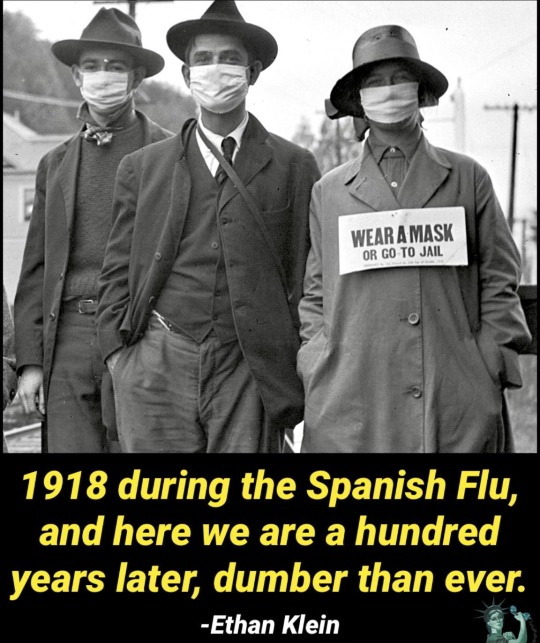
The Cult of Selfishness Is Killing America
The right has made irresponsible behavior a key principle.
Paul Krugman - July 27, 2020
America’s response to the coronavirus has been a lose-lose proposition.
The Trump administration and governors like Florida’s Ron DeSantis insisted that there was no trade-off between economic growth and controlling the disease, and they were right — but not in the way they expected.
Premature reopening led to a surge in infections: Adjusted for population, Americans are currently dying from Covid-19 at around 15 times the rate in the European Union or Canada. Yet the “rocket ship” recovery Donald Trump promised has crashed and burned: Job growth appears to have stalled or reversed, especially in states that were most aggressive about lifting social distancing mandates, and early indications are that the U.S. economy is lagging behind the economies of major European nations.
So we’re failing dismally on both the epidemiological and the economic fronts. But why?
On the face of it, the answer is that Trump and allies were so eager to see big jobs numbers that they ignored both infection risks and the way a resurgent pandemic would undermine the economy. As I and others have said, they failed the marshmallow test, sacrificing the future because they weren’t willing to show a little patience.
And there’s surely a lot to that explanation. But it isn’t the whole story.
For one thing, people truly focused on restarting the economy should have been big supporters of measures to limit infections without hurting business — above all, getting Americans to wear face masks. Instead, Trump ridiculed those in masks as “politically correct,” while Republican governors not only refused to mandate mask-wearing, but they prevented mayors from imposing local mask rules.
Also, politicians eager to see the economy bounce back should have wanted to sustain consumer purchasing power until wages recovered. Instead, Senate Republicans ignored the looming July 31 expiration of special unemployment benefits, which means that tens of millions of workers are about to see a huge hit to their incomes, damaging the economy as a whole.
So what was going on? Were our leaders just stupid? Well, maybe. But there’s a deeper explanation of the profoundly self-destructive behavior of Trump and his allies: They were all members of America’s cult of selfishness.
You see, the modern U.S. right is committed to the proposition that greed is good, that we’re all better off when individuals engage in the untrammeled pursuit of self-interest. In their vision, unrestricted profit maximization by businesses and unregulated consumer choice is the recipe for a good society.
Support for this proposition is, if anything, more emotional than intellectual. I’ve long been struck by the intensity of right-wing anger against relatively trivial regulations, like bans on phosphates in detergent and efficiency standards for light bulbs. It’s the principle of the thing: Many on the right are enraged at any suggestion that their actions should take other people’s welfare into account.
This rage is sometimes portrayed as love of freedom. But people who insist on the right to pollute are notably unbothered by, say, federal agents tear-gassing peaceful protesters. What they call “freedom” is actually absence of responsibility.
Rational policy in a pandemic, however, is all about taking responsibility. The main reason you shouldn’t go to a bar and should wear a mask isn’t self-protection, although that’s part of it; the point is that congregating in noisy, crowded spaces or exhaling droplets into shared air puts others at risk. And that’s the kind of thing America’s right just hates, hates to hear.
Indeed, it sometimes seems as if right-wingers actually make a point of behaving irresponsibly. Remember how Senator Rand Paul, who was worried that he might have Covid-19 (he did), wandered around the Senate and even used the gym while waiting for his test results?
Anger at any suggestion of social responsibility also helps explain the looming fiscal catastrophe. It’s striking how emotional many Republicans get in their opposition to the temporary rise in unemployment benefits; for example, Senator Lindsey Graham declared that these benefits would be extended “over our dead bodies.” Why such hatred?
It’s not because the benefits are making workers unwilling to take jobs. There’s no evidence that this is happening — it’s just something Republicans want to believe. And in any case, economic arguments can’t explain the rage.
Again, it’s the principle. Aiding the unemployed, even if their joblessness isn’t their own fault, is a tacit admission that lucky Americans should help their less-fortunate fellow citizens. And that’s an admission the right doesn’t want to make.
Just to be clear, I’m not saying that Republicans are selfish. We’d be doing much better if that were all there were to it. The point, instead, is that they’ve sacralized selfishness, hurting their own political prospects by insisting on the right to act selfishly even when it hurts others.
What the coronavirus has revealed is the power of America’s cult of selfishness. And this cult is killing us.
https://www.nytimes.com/2020/07/27/opinion/us-republicans-coronavirus.html?action=click&algo=top_conversion&block=trending_recirc&fellback=false&imp_id=739519527&impression_id=c89795d3-d1fd-11ea-abe4-c33d30579de8&index=3&pgtype=Article®ion=footer&req_id=550966833&surface=most-popular
0 notes
Text
16 Things to See and Do in Tallinn, Estonia

Posted: 03/12/20 | March 12th, 2020
Tallinn, the capital of Estonia, is a medieval city nestled against the Baltic Sea. With its picturesque historic Old Town that dates back to the 13th century, it has been drawing in tourists since the fall of the Soviet Union.
Cheap flights, cheap prices, and the beauty of Prague without the crowds have made Tallinn an appealing weekend getaway for Europeans.
I visited the city on a trip from Finland — there’s a frequent ferry service between the two cities — and was enamored by it. It was a blend of Nordic and Baltic culture with plenty of things to see and do.
Best of all, it was super affordable!
Though the city has become a bit more crowded and expensive in the last couple of years, it’s still one of my favorite places in the region. It’s peaceful and wonderful: the people are open and relaxed and the country is super tech-forward (they offer e-residency services specifically for digital nomads).
To help you make the most out of your trip, here are the best things to see and do in Tallinn — from the super touristy to off the beaten trail!
1. Take a Free Walking Tour

One of the best things you can do when you arrive in a new city is to take a free walking tour. They’re a great way to learn about a destination and its history while taking in the main sights.
Not only will it give you a solid introduction to the city but you’ll get access to a local guide who can answer any and all questions you might have.
EstAdventures has a few different free tour options, including general walking tours, tours focused on the city’s communist past, and street art tours. Just make sure to tip your guide!
2. Estonian Maritime Museum
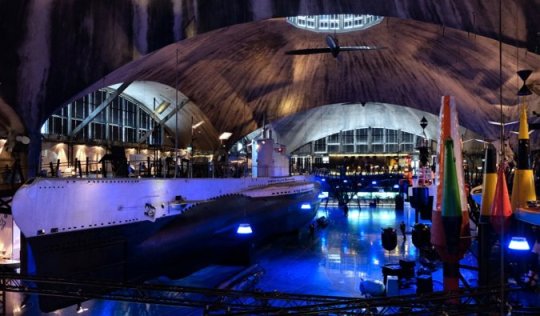
Founded in 1935 and located inside a historic 500-year-old building, this museum highlights the history of Estonia’s maritime culture. The main attraction is the interactive Seaplane Harbour exhibition, which includes a Short 184 seaplane as well as the steam-powered icebreaker Suur Toll.
And don’t miss the 1936 submarine Lembit, the only surviving Baltic warship from before WWII (and one of only two submarines in Estonian naval history). There’s also an aquarium, ship miniatures, and a flight simulator. It’s a fun and educational place for adults and kids alike.
Vesilennuki tee 6, +372 6200 550, meremuuseum.ee. Open Tuesday–Sunday 10am–6pm; closed Monday. Admission: 15 EUR.
3. Glehn Park & Castle
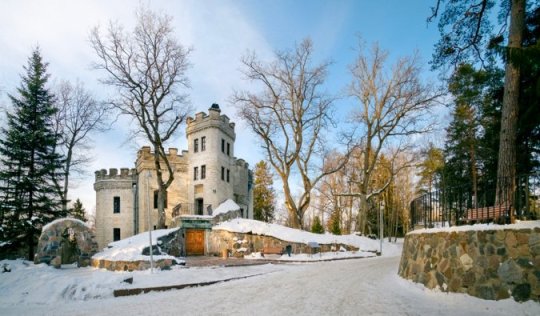
Glehn Park, located on the Nomme hillside, is home to medieval-style Glehn Castle. Built in 1886, both the park and castle were created by Nikolai von Glehn, a rich and eclectic man known for his unusual taste in decoration (such as tables and chairs carved like figurines, large statues, and an obelisk in front of his house marking the grave of his favorite horse).
Unfortunately, most of the castle was looted during World War I, so none of the unique pieces of furniture he created remain. However, you’ll still get to see the statues he built on the grounds of the park. There’s also an observatory tower and palm house, which has a gorgeous mosaic rooftop. It’s a good place to relax, go for a walk, or go skiing during wintertime.
Vana-Mustamäe 48, +372 652 5076, ttu.ee/organisatsioonid/glehni-loss. The building isn’t open to the public as it is now used for events (weddings, conferences, receptions, etc.).
4. Tallinn Town Hall & Square

Tallinn’s Gothic town hall is the oldest in the Baltics. Completed in 1404, it boasts a 64m spire topped with a weather vane of an old warrior (named Old Thomas), a Tallinn city guard and hero from the 16th century who fought in the Livonian War.
You can climb the spire to 34 meters (111 feet) from May through September. The interior of the Town Hall is open to visitors as a museum only during July and August; inside, you’ll get to see colorful designs on the walls, intricate wood carvings, and stunning arched ceilings as you learn about the city and its history.
The surrounding plaza is a great place to people-watch and it hosts lots of activities and markets throughout the year.
Don’t miss the annual five-day Tallinn Old Town Days festival held in May. It’s dedicated to the cultural heritage of Tallinn and includes themed days such as Medieval Day and Children’s Day, as well as numerous workshops, music, and theatre performances.
Raekoja plats, Kesklinna linnaosa (City Center), +372 645 7906, raekoda.tallinn.ee/. Open weekdays from 10am-4pm. Advance reservations required. Admission is 5 EUR.
5. Tallinn Museum of Photography

Hidden amidst the cobblestone streets of Tallinn, this small museum is tucked away inside a 14th-century prison. It focuses on Estonia’s history of photography with a permanent exhibition including antique photos and cameras from 1840 — when photography first made its way to Tallinn — to 1940.
You can also check out contemporary photography from modern-day artists in many of the museum’s rotating exhibits. It’s a very small museum, but super interesting even if you’re not a huge photography buff.
Raekoja 4/6, +372 644 8767, linnamuuseum.ee/fotomuuseum. Open Saturday, Wednesday, and Friday from 10am–5pm, Thursdays from 12–8pm, and Sunday from 11am–4pm. Closed Monday and Tuesday.
6. Estonian Open-Air Museum

Located 15 minutes from the city center by car, this open-air ethnographic museum recreates what life was like in Estonia’s rural countryside. It’s a life-sized rural village composed of farms, a wooden chapel, a school, fire station, shop, and an inn that highlights how families from different social classes lived during the 18th and 19th centuries.
There’s plenty to do, from eating a traditional Estonian meal to riding a horse to taking a workshop. It’s open all year round, but you might want to go during the summertime when it’s warm! It’s also one of the best things to do in Tallinn with kids. Download the mobile app Numu for a free audio guide while you’re at the museum.
Vabaõhumuuseumi tee 12, +372 654 9100, evm.ee/est/avaleht.Open daily from 10am–5pm. Admission is 8 EUR. Free entrance with a Tallinn Card.
7. Ichthus Art Gallery
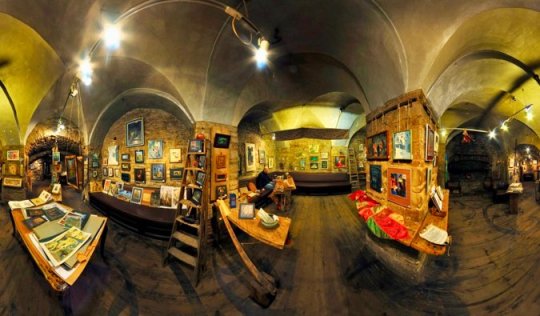
This is one of Tallinn’s best-kept secrets. It’s tucked away in the depths of St. Catherine’s Dominican Monastery, which dates back to 1246. On arrival, turn right toward steep steps that take you into the cellar. The confined space used to contain three wings, called the Claustrum, that housed monks in the 13th century.
Today, the space is used by artist Aleksandr Savchenkov, who sells his original artwork from the cellar. As you wander about you’ll also see the ‘Energy Pillar’, which is located in the ancient monastic chambers and is said to be a source of spiritual well-being.
Müürivahe Tänav 33, +372 5559 5920. Admission is free; however, donations are accepted.
8. Epitaphs of the Cathedral of Saint Mary

The grounds of this church date back to the 13th century, though the current building itself is from the 17th. What makes it unlike most other churches is that coats-of-arms epitaphs hang on the walls of the church instead of more traditional religious artwork or decorations.
Historically, these were used as headstones for people of importance, such as nobles and knights. They reflect the people of status who were buried on the grounds.
In fact, the first man who ever led a Russian voyage around the world, Admiral Adam Johan von Krusenstern, is buried here. Climb the 69-meter (226-foot) bell tower to get a beautiful view of the city.
Toom-Koolitänav 6, +372 644 4140. Open Tuesday–Sunday 10am–3:30pm, closed Mondays. Admission is 5 EUR for adults and 3 EUR for children. Dress respectfully as this is a place of worship.
9. Estonian Architecture Museum

The Estonian Architecture Museum was established in 1991 during the fight for Estonian independence. The museum is located in the Rotermann Salt Storage building, which was built in 1908 (and then reconstructed in 1995 with multiple additional floors for the museum).
Its galleries now feature drawings from the 1920s, as well as over 11,500 archived items (such as drawings and sketches) and some 18,000 items in their photo collection. There are always some interesting rotating exhibits here too.
Ahtri tänav 2, +372 625 7000, arhitektuurimuuseum.ee. Open Tuesday–Sunday 11am–6pm, closed Mondays. Admission is 6 EUR.
10. TV Tower

Adrenaline junkies will get a kick out of visiting the TV Tower. Not only will you have an incredible bird’s-eye view of Tallinn from the top, which stands 314 meters (1,030 feet) tall, but you can also try the Walk on the Edge experience. Hop into a harness and step outside of the tower onto the exposed deck. It’s the highest open deck in Northern Europe and offers both an amazing view and a huge rush!
The TV Tower was constructed when Tallinn was chosen as a host city for sailing during the 1980 Moscow Olympics. It closed in 2007 for renovations and reopened in 2012. It has floor-to-ceiling windows (not ideal if you’re afraid of heights) so you can really soak in the view as well as touch-screen information panels so you can learn about the tower and the city.
The tower hosts many events, such as music concerts and the annual Stair Run to mark the anniversary of its reopening.
Kloostrimetsa tee 58 A, +372 686 3005, teletorn.ee. Admission is 13 EUR and the Walk on the Edge costs 30 EUR.
11. Telliskivi Creative City
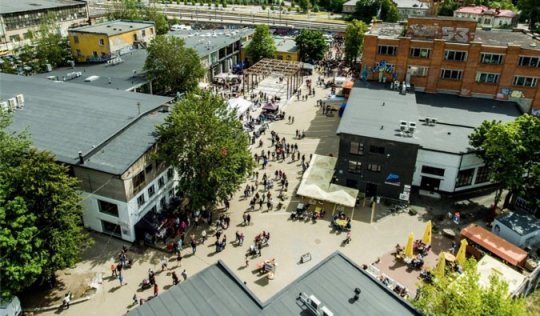
The Telliskivi Creative City is a workplace for over a thousand people, with artist’s studios, a radio station, rehearsal spaces, and NGO offices, all situated throughout ten repurposed factory buildings. Telleskivi hosts a flea market every Saturday, and there are over 600 cultural events throughout the year, including dance performances, music concerts, and improv theatre.
There are colorful murals on many of the buildings and you’ll also find restaurants and bars full of locals and tourists alike. Make sure you eat at Peatus (“Stop” in Estonian) for a really unique experience: it’s located inside two old Soviet railcars (and the food is great too!).
Telliskivi tänav 60a, Pohja, Tallinna linnaosa.
12. Bastion Tunnels
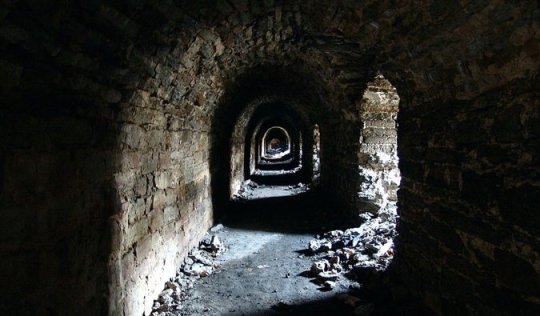
These tunnels were initially built in the 17th century as an addition to the Kiek in de Kök (Peek in the Kitchen) tower, and were intended for storage. They later held prisoners and then were used as shelters against air raids during World War II.
In more modern history, thieves and rebels used them for shelter since the police usually avoided the tunnels. They were cleaned out and opened up to the public in 2004. If you’re brave enough, you can explore the winding maze of the dark, damp tunnels on a guided tour when you visit the tower.
Komandandi tee 2, +372 644 6686, linnamuuseum.ee/kiek-de-kok. Open Tuesday–Sunday 10am–5pm (Thursday until 8pm), closed Monday. Admission is 14 EUR.
13. Toompea Castle & Alexander Nevsky Cathedral
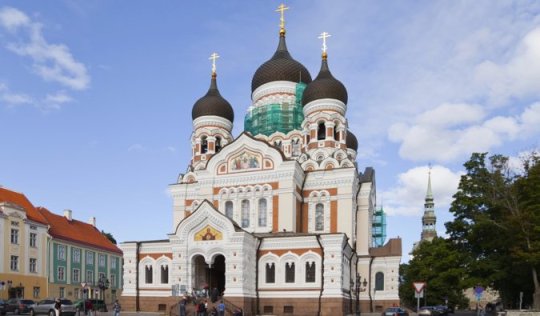
Toompea Castle dates all the way back to the 9th century and is currently used by Riigikogu, Estonia’s Parliament. The east wing has a brightly colored pink and white exterior in baroque style, as ordered by Empress Catherine the Great in 1773. The opposing side still has its medieval stone exterior. The Estonian flag is raised above the tower at sunrise every day.
You can also visit the nearby Alexander Nevsky Cathedral. It opened in 1900 during the Czarist Empire and is home to Tallinn’s largest bell (it weighs 15 tons). The impressive exterior showcases Russian Revival architecture with its onion-shaped dome. The interior is decorated with colorful mosaics and stained-glass windows and has three ornate altars.
Toompea Castle: Lossi plats 1a, +372 631 633, riigikogu.ee. On Thursdays at 11am, there’s a 45-minute English-language tour of the castle. Admissions is free though you need to reserve your spot in advance.
Alexander Nevsky Cathedral: Lossi plats 10, +372 644 3484, cathedral.bg/en/home. Open daily from 7am-7pm. Admission is free. Dress respectfully as it is a place of worship.
14. Soviet Statue Graveyard

The Soviet Statue Graveyard, located near Maarjamäe Castle, contains a collection of discarded statues, such as those of Joseph Stalin, Vladimir Lenin, and Mikhail Kalinin. After the Soviets left Tallinn, they were dumped here and ignored.
You’ll find large statues of heads (a classic Soviet statue trend) and others that tower over three meters (ten feet) tall. It’s a surreal place to visit — especially when you realize it hasn’t even been 30 years since Estonia achieved independence and these statues were left to fade into history.
Pirita tee 56, 10127, ajaloomuuseum.ee/exhibitions/permanent-exhibitions/noukogude-aegsete-monumentide-valinaitus. Open Tuesday–Sunday 10am–6pm, closed Monday.
15. KGB Museum

Rooms previously used by spies during the Soviet era sit on the top floor of the stylish Hotel Viru, located on Viru Square. They house listening and recording equipment (some cleverly disguised), dial telephones, uniforms, and a typewriter.
Few people ever knew these rooms existed, and they were only exposed in the 1990s when the KGB fled the city. They shed light on just how controlling and subversive the Soviet government was during the occupation.
Viru väljak 4, +372 680 9300, viru.ee/en. Open daily from 10am–5pm. The guided tour begins in the hotel lobby.
16. Take in the View

For the best view in the city, head to Kohtuotsa viewing platform. It’s on Toompea Hill and offers the best view of the city and harbor. You’ll also often find buskers here, making it a nice place to end your day and watch the sunset.
***
Tallinn remains one of my favorite destinations in Europe. It’s a fun and lively city home to quirky museums, hidden art exhibits, and beautiful architecture.
Go enjoy all the wonderful things to do here.
Book Your Trip to Estonia: Logistical Tips and Tricks
Book Your Flight
Find a cheap flight by using Skyscanner or Momondo. They are my two favorite search engines because they search websites and airlines around the globe so you always know no stone is left unturned.
Book Your Accommodation
You can book your hostel with Hostelworld. If you want to stay elsewhere, use Booking.com as they consistently return the cheapest rates for guesthouses and cheap hotels. My favorite hostel in the city is:
Tallinn Backpackers – This is a lively, social hostel that makes it easy to meet people since they have a pub crawl every night. The staff are great too!
Don’t Forget Travel Insurance
Travel insurance will protect you against illness, injury, theft, and cancellations. It’s comprehensive protection in case anything goes wrong. I never go on a trip without it as I’ve had to use it many times in the past. I’ve been using World Nomads for ten years. My favorite companies that offer the best service and value are:
World Nomads (for everyone below 70)
Insure My Trip (for those over 70)
Looking for the best companies to save money with?
Check out my resource page for the best companies to use when you travel! I list all the ones I use to save money when I travel – and I think will help you too!
Photo credit: 3 – Vladimir Varfolomeev, 4 – Holger Vaga, 5 – Pudelek, 6, 7 – Sander Säde, 8, 9 – Zairon, 10 – Nosser, 11 – Sheila Dee, 12 – Relkmsaiia, 13 – Narva69, 14 -Diego Delso, 15 – Ferran Cornella, 16, 17 – PIERRE ANDRE LECLERCQ
The post 16 Things to See and Do in Tallinn, Estonia appeared first on Nomadic Matt's Travel Site.
from Nomadic Matt's Travel Site https://ift.tt/2IJaqRA
via IFTTT
0 notes
Text
Jeremy Corbyn speech to Cooperative Party Conference
Jeremy Corbyn MP, Leader of the Labour Party, speaking at the Cooperative Party Conference said:
***CHECK AGAINST DELIVERY***
Thank you Gareth for that introduction, it’s a pleasure to be addressing your centenary conference.
Our movement was in its early days inspired by the actions of William Morris and Robert Owen. Owen spoke of “the union and co-operation of all for the benefit of each”. Those two words “union” and “co-operation” mean so much to our movement. They are our philosophy, and our institutions, our theory and our practice.
This is an important landmark in your history, but more importantly this is a significant moment for our future.
The energy and creativity of our movement helped us to deliver in June the biggest increase in the Labour vote since 1945.
And that helped us deliver nine more Labour and Co-operative MPs from Brighton to Glasgow, bringing the total now to 38 in Parliament - more than in either 1945 or 1997.
The strength of our movement - Labour, trade union and co-operative, and more importantly co-operating - has transformed us into a government-in-waiting.
Next May we have local elections in cities and towns across England. Let’s build on the 900 Labour and Co-operative councillors we have. Today let’s set ourselves the challenge to make it over 1,000 Labour Co-op councillors on May 3rd.
The Tories have devolved austerity to local councils and perversely areas with higher levels of poverty have been hit hardest. Councils have on average faced 40% cuts in their budgets. But in the face of this adversity councils such as Preston have responded with inspiring innovation. They brought together major local employers in their community, what academics call the anchor institutions, and Preston council worked with them to drive through a local programme of economic transformation. By changing their procurement policies, these anchor institutions were able to drive up spending in Preston by £75 million, protecting businesses and jobs.
And they’re looking at the pension fund they are part of to see where investment can support local businesses, keeping the money circulating in their city. But perhaps most relevantly to you, the council is actively seeking opportunities to create worker-led co-operatives where there are gaps in the local supply chain.
Our movement, the labour and co-operative movement, is brimming with passion, people and ideas. And our movement needs your ideas and I know our shadow cabinet values your input as well.
This afternoon you'll hear from shadow education minister Tracy Brabin, talking about our plans for a National Education Service, a vision for education in which institutions of learning co-operate rather than compete. And tomorrow our shadow International Development Secretary Kate Osamor, herself a Labour and Co-operative MP, will address you to outline our international policy based on our values of peace, justice and co-operation.
We live in a world riven by conflict, spurred on by ego and neo-imperial ambition. Never has the time been more important to restate our commitment to the UN Charter, the third clause of which states its aim “To achieve international co-operation in solving international problems”.
With the problems facing us of nuclear proliferation, climate change, the global refugee crisis, the humanitarian crises in Syria, Yemen and of the Rohingya in Myanmar - a global vision driven by our co-operative principles is more necessary than ever. Whether its Donald Trump or Kim Jong-Un - macho posturing needs to give way to calm, rational co-operation. And across the world co-operatives play such a huge role as a spur to development, empowering women, bringing communities together. And today there are over a billion people worldwide who are members of co-operatives and I am proud to say that I am one of them.
We need co-operative values at home and abroad.
Our economy is failing to deliver.
For millions of people the current system is failing to deliver secure jobs, failing to deliver secure housing, and failing to deliver rising living standards.
Yet this is the system which exploits the many for the profits of a few, that the Conservatives want to defend. They want to conserve the privilege of the few.
Philip Hammond says that Labour poses an “existential challenge to our economic model” - Yes, we do.
I am not going to sit back when their economic model is seeing:
- homelessness double
- four million children in poverty
- over a million older people not getting the care they need
Their economic model is broken. It doesn’t work for most people. Even the International Monetary Fund thinks inequality and low taxes for the richest are harming the economy.
That’s why Labour is now the new mainstream, developing a new consensus of how to run an economy for the many not the few.
This new consensus will reward the real wealth creators - that means all of us. It will genuinely value people and communities - and invest in them. It will create an economy fit for the 21st Century with a state that’s not afraid to act when something goes wrong but, more importantly, also proactive to make sure things work in the first place.
Unlike Mr Hammond and the Conservatives I don’t think it’s acceptable that chief executives get 180 times the pay of their average worker. I don’t think it’s acceptable that when hospital A&Es are closing the government can fund another tax giveaway for big business. And I don’t think it’s right that landlords can be paid £10 billion a year in housing benefit without even the requirement that the home is fit for human habitation.
The Conservatives believe everyone is motivated by the same base interests - selfishness and greed.
For all their rhetoric they don’t even begin to understand the entrepreneurial spirit they claim to champion. When I meet entrepreneurs, and those trying to start their own business, their motivations are to express their creativity, serve their community, meet people’s needs, to create an income for themselves and jobs for others.
Their inspiration is often closer to the pragmatic principles of the co-operative movement than it is to the abstract ideology of Milton Friedman.
So I say to people thinking of starting an enterprise or those struggling to run a start-up - consider the co-operative model and get the support you need from Co-operatives UK.
But conference, we have to acknowledge the obstacles to the Co-operative model. Too often people who want to change their community or start a business don’t know about the co-operative movement. And yet co-operative start-ups are more robust than other forms of business start-up - twice as likely to still be in operation five years later.
The co-operative sector in the UK is one-fifth of the size of Germany’s - under-valued and under-appreciated. A Labour government will change that.
We will promote the co-operative option and support you to double the size of the co-operative economy. This isn’t just an aspiration - John McDonnell and Rebecca Long-Bailey have set out how we will:
- bring forward legislation to create a proper legal definition for co-operative ownership
- ensure that workers have a right to own, when a company is facing change of ownership or closure
- establish regional development banks that will help deliver low cost finance to co-operatives
- support the creation of publicly owned, locally accountable energy companies and co-operatives
Because we support co-operative principles, they are Labour principles.
To build a new high-investment economy for the 21st century we must get Brexit right. That means securing full access to the Single Market and using the powers we get back from Brussels to help transform our economy.
The Tories are transparently failing Britain in the Brexit negotiations. They are making a shocking mess of Brexit. They are split down the middle, negotiating with each other instead of the EU.
With each passing day they are driving us closer to a ‘no deal’ Brexit. Let’s be clear: no deal is the worst possible deal. It would leave us with World Trade Organisation tariffs and restrictions instead of the full access to European markets we need.
The risk would be that key manufacturers leave for the European mainland taking skilled jobs with them. In sector after sector, ‘no deal’ could prove to be an economic disaster.
Theresa May’s cabinet of chaos is risking a jobs meltdown across Britain. A powerful faction of the Conservatives want a no-deal outcome because they think they can use it to turn our economy into a deregulated tax haven. We must not let them.
So when we talk about taking natural monopolies into public ownership we’re not inspired by the centralised and remote models of the 1940s and 1950s. We’re determined to create models of ownership that involve workers and consumers based on Co-operative principles, whether that’s at community, regional or national level.
Last year the profit margins at the big six energy firms hit their highest level on record, falling wholesale costs were not passed on, and since then providers like British Gas have hiked prices again by 12.5%.
Why does this happen?
Because energy is run for profit, for the interests of the few over the many.
Our shadow energy team has just returned from Denmark, a country where the grid is publicly owned and municipal and co-operative ownership dominates.
And look at what this has allowed them to achieve:
- a 30% reduction in industry use of fossil fuels
- an overall 40% CO2 reduction
- a reduction in energy consumption
- and by 2020 Denmark will get 50% of its electricity from wind.
British people are being short-changed by a system that is failing:
- failing to provide energy at an affordable rate
- failing to invest in new technology to tackle climate change
- and failing to deliver clean air.
And I want to say a word about Royal Mail, taking legal action against the will of their own staff rather than negotiating with them and their union
And look at what has happened since privatisation: The company has made £195 million in profits through the sale of assets and closed one in 10 delivery offices, running down and asset stripping the service.
They’ve paid out over £600 million in dividends to private shareholders - that’s £344 every minute since privatisation. And of course the public business was sold off on the cheap by the Lib Dem and Tory coalition.
That’s why we have committed to bringing Royal Mail into public ownership - run in the interest of the public, Royal Mail workers and service users.
I want to end my speech with a challenge to you in the Co-op Party, and to those in the wider co-operative movement - come forward with your ideas, your enthusiasm, your energy.
We have an opportunity in this period of opposition to prepare for government - a Labour government that will transform our economy to work for the many not the few. So contribute your ideas into the Labour Party.
Two areas where I think we can do something practical in the here and now. We know that co-operative start-ups are more likely to survive than conventional business start-ups so what can you as a movement do now, to engage with entrepreneurs to take up the co-operative model, working with local chambers of commerce and the Federation of Small Businesses. Let’s get Labour councils, the co-operative movement, and small business organisations working together to promote the co-operative model.
And finally, I believe that we are entering a period of unprecedented opportunity for socialist politics and co-operative principles. New technology is empowering participation, new social movements today are horizontalist rather than hierarchical, networked rather than top-down. That’s why when I ran to be Labour leader I said I wanted our party to be a movement. And today we are with well over half a million members who joined because they want to be involved and want to participate in our movement.
The top-down model of organisation, whether in politics, the media or in business, is being challenged and is breaking down.
The technology of the digital age should be empowering workers, enabling us to co-operate on a scale not possible before and yet too often it has enabled a more rapacious and exploitative form of capitalism to emerge.
Look at Uber, Deliveroo, and others. The platforms these companies use are the technologies of the future. But, too often, their business models depend not on technological advantage, but on establishing an effective monopoly in their market and using it to drive wages and conditions through the floor.
Governments have to make sure that regulation keeps pace with changing technologies.
But sensible regulation of working conditions would not only improve the lot of existing workers – and yes, despite what some firms try to claim, they are workers – it would mean that new businesses could survive in the market.
Digital platforms are opening up huge opportunities for horizontal, more democratic, forms of organisation to flourish.
Imagine an Uber run co-operatively by their drivers, collectively controlling their futures, agreeing their own pay and conditions, with profits shared or re-invested. The next Labour Government, working with you, can make that a reality.
The biggest obstacle to this is not technological but ourselves. We must have the confidence and organisational skill to make it happen. That’s why we commissioned our report on Alternative Models of Ownership. To start asking fundamental questions about who should own our economy in the digital age, and how to ensure that it’s enormous potential benefits serve the many, not the few.
Its authors recommend that co-operatives be supported by government through access to finance, through legal changes to level the playing field for cooperatives in the market, and through a better government procurement policy, so that public money is being used to support companies that serve the public good.
To prevent just the few benefiting from the “rise of the robots” the report suggests we consider higher minimum wages, a shorter working week, profit sharing schemes, or putting the ownership and control of the robots in the hands of those who work with them and come to rely on them.
We don’t have all the answers yet but are thinking radically about how we can shape the next thirty years to use the power of new technology to make our economy work for the many not the few.
Today Labour and Co-op parties are the largest in Britain with more members than all the other parties combined. We are winning the arguments … with support for public and co-operative ownership. And we are inspiring millions.
We are a movement ready to take office and ready to shape our country for the future.
Conference, thank you.
8 notes
·
View notes
Text
Amnesty Exposes Navalny as No Victim
LOS ANGELES (OnlineColumnist.com), Feb. 25, 2021.--Dispelling a myth that 44-year-old Russian dissident Alexi Navalny is a “prisoner of conscience” in Russia, Amnesty International removed Navalny off its prisoner of conscience list, citing past statement advocating hate. President Joe Biden, 78, his 58-year-old Secretary of State Tony Blinken and 44-year-old National Security Adviser Jake Sullivan have rushed to Navalny’s defense, threatening to sanction the Kremlin unless 68-year-old Russian President Vladimir Putin releases Navalny from prison. Amnesty admitted that Navalny’s statements “reach the threshold of advocacy of hatred,” something that surprises the U.S. and European Union [EU], both ready to sanction Putin over Navalny’s incarceration. Whatever the charges against Navalny, phony or not, the 44-year-old dissident is no angel, developing a network around Russia calling for street demonstrations to oust Putin.
If any U.S. or EU opposition leader advocated the overthrow of Washington or Brussels they’d immediately be targeted by the FBI or EU’s Interpol for subversion. Yet after the Jan. 6 Capitol riot, Democrats in Congress charged 74-year-old former President Donald Trump with “incitement of insurrection,” a high-crime-and-misdemeanor accusing Trump of sedition. Can you imagine, a U.S. president was charged with “incitement of insurrection” for delivering a speech, with nine House manager pleading with the U.S. Senate to convict Trump. All nine House managers didn’t care that the Capitol riot and mob scene was planned months in advance, proving there was nothing in Trump’s speech that resulted in the Capitol rampage. Yet when it comes to Putin, the U.S. and EU are ready to sanction the Russian Federation based on pure propaganda from Navalny and his Chief of Staff Leonid Volkov.
U.S. and EU officials have been duped by Navalny, who’s running a crypto-sedition network trying to sabotage Putin’s 20-year reign of power. Amnesty International points out that Navalny has made hateful statements that don’t meet the groups definition of a “prisoner of conscience.” When Navalny returned to Moscow Jan. 17 after spending two months in Berlin recovering from alleged Novichok poisoning, what did he think would happen once he returned? Navalny and Volkov obviously thought there would be so much pressure on the Kremlin, they wouldn’t dare convict him of a probation violation. No one told Navalny to return to Russia, especially knowing he’s been calling for potentially violent street demonstration demanding Putin resign. Amnesty can’t have it both ways, calling Navalny a “freedom fighter,” and, at the same time, recognize he advocates the violent overthrow of the Russian government.
Amnesty’s public statement should give the U.S. and EU pause when it comes to slapping the Russian Federation with new economic and travel sanctions. “Some of these comments, which Navalny has not publicly denounced, reach the threshold of advocacy of hatred, and this is at odds with Amnesty’s definition of a prisoner of conscience,” read Amnesty. Admitting that Navalny’s a garden variety Trotskyite, a revolutionary trying to topple Russia’s government, should give Biden and EU’s Ursula von der Leyen reason to stop the madness of sanctioning the Russian Federation. Whatever internal problems Russia has with Navalny, the U.S. and EU have far too many common interests with the Russian Federation to turn Putin into an adversary. Under threat of new sanctions, Putin’s already asked the Federal Security Service [FSB] to prepare to counter foreign influences to undermine the Russian state. Amnesty International tried to backtrack once they realized they discredited Navalny.
“This distraction only serves the Russian authorities, who have jailed Navalny on politically motivate charges, simply because he dared to criticize them,” said AI Secretary-General Julie Verhaar. “We note that some of Alexi Navalny’s past comments have been actively used by his opponents to discredit him,” Verhaar said. Verhaar can’t have it both ways, removing Navalny off the “prisoner of conscience” list, claiming his past statements were manipulated by his enemies. Verhaar ignores the fact that Navalny is a subversive working day-and-night to undermine Putin’s government. U.S. and EU officials should think twice about advocating on behalf of Navalny, when they need a strong relationship with the Russian Federation to improve chances of maintaining world peace especially in volatile regions.
Amnesty International can’t get out its own way, stripping Navalny to “prisoner of conscience” status but, at the same time, trying to say her really represents the future of Russian democracy. Navalny once referred to Chechens as “cockroaches,” urging “the pistol” as the best way of getting rid of them. “We have a right to be [ethnic] Russians in Russia. And we’ll defend that right,” Navalny said in 2007. Whether Navalny’s more politically correct today is anyone’s guess. What’s known for sure is that he runs a cryptic organization designed to topple the Russian government. Navalny “still has nationalistic leanings,” said Julia Davis, a Russian media and disinformation expert. No Western power should denounce Putin and the Kremlin because of Navalny, a known revolutionary looking to overthrow the Russian government. However Putin deals with Navalny is purely an internal matter.
About the Author
John M. Curtis writes politically neutral commentary analyzingspin in national and global news. He’s editor of OnlineColumnist.com and author of Dodging The Bullet and Operation Charisma.
0 notes